Lynching in the United States
Lynching in the United States was a widespread occurrence beginning in the 1830s Antebellum South until the civil rights movement in the 1950s and 1960s. Although the victims of lynching in the U.S. for the first few decades of the phenomenon were predominantly white Southerners, after the American Civil War emancipated roughly 4 million enslaved African-Americans, they became the primary targets of lynchings beginning in the Reconstruction era. Lynchings in the U.S. reached their height from the 1890s to the 1920s, and primarily targeted African-Americans and other ethnic minorities. The American South saw the majority of lynchings as it contained the largest number of African-Americans residing there, although racially motivated lynchings occurred in the Midwest and border states as well.
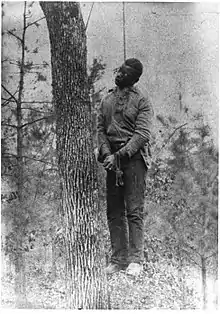
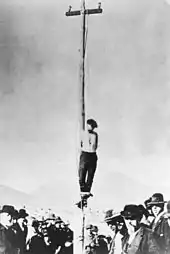

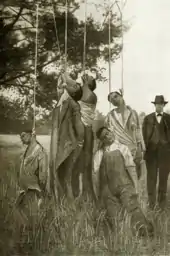
_(NBY_7660).jpg.webp)
These coincided with the Great Migration of African-Americans out of the American South, and were often perpetrated to enforce white supremacy and intimidate ethnic minorities through racial terrorism. A significant number of lynching victims were accused of murder or attempted murder. Rape, attempted rape or other forms of sexual assault were the second most common accusation; often being pretexts for lynching African-Americans who violated Jim Crow-era etiquette or engaged in economic competition with whites. Approximately one-third of the victims were falsely accused. According to the Tuskegee Institute, 4,743 people were lynched between 1882 and 1968 in the United States, including 3,446 African Americans and 1,297 whites.
A common perception of lynchings in the U.S. were hangings, due to their public visibility, which made it easier for photographers to photograph the victim. Some lynchings were professionally photographed and as postcards, which became popular souvenirs in parts of the United States. Lynching victims were also killed in a variety of other methods; being shot, burned alive, thrown off a bridge, dragged behind a car, etc. Occasionally, body parts of victims were removed and sold as souvenirs. Lynchings were not always fatal; "mock" lynchings, which involved putting a rope around the neck of someone suspected of concealing information, was sometimes used to compel "confessions.
According to American historian Michael J. Pfeifer, the prevalence of lynching in postbellum America reflected a lack of confidence in the "due process" of the U.S. judicial system. He links the decline in lynching in the early twentieth century with "the advent of the modern death penalty": "legislators renovated the death penalty...out of direct concern for the alternative of mob violence". Pfeifer also cited "the modern, racialized excesses of urban police forces in the twentieth century and after" as bearing characteristics of lynchings.[2] On April 26, 2018, in Montgomery, Alabama, The National Memorial for Peace and Justice opened. Founded by the Equal Justice Initiative of that city, it is the first large-scale memorial created to document lynchings of African Americans in the United States.
Background
Prior to the Civil War most of the victims of lynching in the South were white men.[3] During the Reconstruction era lynchings were used to enforce white supremacy and intimidate blacks by racial terrorism.[4] The rate of lynchings in the South has been strongly associated with economic strains,[5] although the causal nature of this link is unclear.[6] Low cotton prices, inflation, and economic stress are associated with higher frequencies of lynching.
The Fourteenth Amendment to the U.S. Constitution declared that all born in the United States were citizens, and the Fifteenth that all citizens could vote, regardless "of race, color, or previous condition of servitude." These were regarded as self-destructive mistakes by many white Southerners. Some blamed freedmen for their own wartime hardships, post-war economic problems, and loss of social and political privilege. During Reconstruction, freedmen, and white people working in the South for civil rights, were attacked and sometimes lynched. Black voting was suppressed by violence as well as by poll taxes and literacy tests. Whites regained control of state legislatures in 1876, and a national compromise resulted in the removal of federal troops from the South in 1877. In later decades, violence continued around elections until blacks were disfranchised by the states from 1885 (see Florida Constitution of 1885) to 1908 through constitutional changes and laws that created barriers to voter registration across the South.
White Southern Democrats enacted Jim Crow laws to enforce blacks' second-class status (see Nadir of American race relations). During this period that spanned the late 19th and early 20th centuries, lynchings reached a peak in the South. Georgia led the nation in the number of lynchings from 1900 to 1931 with 302 incidents, according to The Tuskegee Institute. However, Florida led the nation in lynchings per capita from 1900 to 1930.[7][8][9] Lynchings peaked in many areas when it was time for landowners to settle accounts with sharecroppers.[10]
There is no count of recorded lynchings that claims to be precise, and the numbers vary depending on the sources, the years considered, and the definition used to define an incident. The Tuskegee Institute has recorded the lynchings of 3,446 blacks and 1,297 whites between 1882 and 1968, with the peak occurring in the 1890s, at a time of economic stress in the South and increasing political suppression of blacks.[11] A five-year study published in 2015 by the Equal Justice Initiative found that nearly 3,959 black men, women, and children were lynched in the twelve Southern states between 1877 and 1950. Over this period Georgia's 586 lynchings led all states.[12][13][14]
African Americans mounted resistance to lynchings in numerous ways. Intellectuals and journalists encouraged public education, actively protesting and lobbying against lynch mob violence and government complicity. Anti-lynching plays and other literary works were produced. The National Association for the Advancement of Colored People (NAACP), and related groups, organized support from white and black Americans, publicizing injustices, investigating incidents, and working for passage of federal anti-lynching legislation (which as of 2019 has still not passed). African-American women's clubs raised funds and conducted petition drives, letter campaigns, meetings, and demonstrations to highlight the issues and combat lynching.[15] In the great migration, particularly from 1910 to 1940, 1.5 million African Americans left the South, primarily for destinations in northern and mid-western cities, both to gain better jobs and education and to escape the high rate of violence. From 1910 to 1930 particularly, more blacks migrated from counties with high numbers of lynchings.[16]
From 1882 to 1968, "nearly 200 anti-lynching bills were introduced in Congress, and three passed the House. Seven presidents between 1890 and 1952 petitioned Congress to pass a federal law."[17] None succeeded in gaining passage, blocked by the Solid South—the delegation of powerful white Southerners in the Senate, which controlled, due to seniority, the powerful committee chairmanships.[17] During the civil rights movement of the 1950s and 1960s, black activists were attacked and murdered throughout the South. The 1964 Mississippi Burning murders galvanized public support for passage of civil rights legislation that year and the next.
Name origin
The term "Lynch's Law" apparently originated during the American Revolution when Patriot Charles Lynch, a Virginia justice of the peace, ordered extralegal punishment for Loyalists. In the Antebellum South, members of the abolitionist movement and other people opposing slavery were sometimes targets of lynch mob violence.[18]
Social characteristics
.jpg.webp)
During the Civil War, Confederate Home Guard units sometimes lynched white Southerners whom they suspected of being Unionists or deserters. One example of this was the hanging of Methodist minister Bill Sketoe in the southern Alabama town of Newton in December 1864.
A major motive for lynchings, particularly in the South, was the white society's efforts to maintain white supremacy after the emancipation of slaves following the American Civil War. It punished perceived violations of customs, later institutionalized as Jim Crow laws, which mandated racial segregation of whites and blacks, and second-class status for blacks. A 2017 paper found that more racially segregated counties were more likely to be places where whites conducted lynchings.[19] Economic competition was another major factor; independent black farmers or businessmen were sometimes lynched or suffered destruction of their property. In the Deep South, the number of lynchings was higher in areas with a concentration of blacks in an area (such as a county), dependent on cotton at a time of low cotton prices, rising inflation, and competition among religious groups.
Whites sometimes lynched blacks for financial gain, and sometimes to establish political or economic dominance. These lynchings emphasized the new social order constructed under Jim Crow; whites acted together, reinforcing their collective identity along with the unequal status of blacks through these group acts of violence.[20] In much of the Deep South, lynchings peaked in the late 19th and early 20th centuries, as white racists turned to terrorism to dissuade blacks from voting in a period of disenfranchisement. In the Mississippi Delta, lynchings of blacks increased beginning in the late 19th century as white planters tried to control former slaves who had become landowners or sharecroppers. Lynchings had a seasonal pattern in the Mississippi Delta; they were frequent at the end of the year when sharecroppers and tenant farmers tried to settle their accounts.
In the 1890s, African-American journalist and anti-lynching crusader Ida B. Wells conducted one of the first thorough investigations of lynching cases. She found that black lynching victims were accused of rape or attempted rape about one-third of the time (although sexual infractions were widely cited as reasons for the crime). The most prevalent accusation was murder or attempted murder, followed by a list of infractions that included verbal and physical aggression, spirited business competition, and independence of mind among victims. Lynch mob "policing" usually led to white mobs murdering persons suspected of crimes or more casual infractions.
Lynchings also occurred in Western frontier areas where legal recourse was distant. In the West, cattle barons took the law into their own hands by hanging those whom they perceived as cattle and horse thieves. This was also related to a political and social struggle between these classes.
Lynchings were in part intended as a voter suppression tool. A 2019 study found that lynchings occurred more frequently in proximity to elections, in particular in areas where the Democratic Party faced challenges.[21]
The West
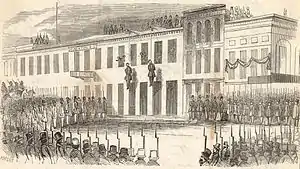
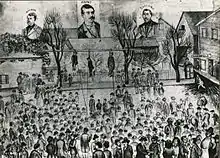
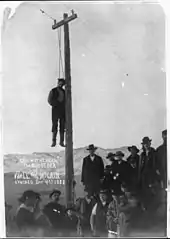
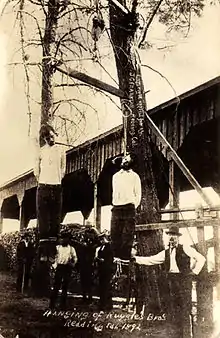
Historians have debated the history of lynchings on the western frontier, which has been obscured by the mythology of the American Old West. In unorganized territories or sparsely settled states, law enforcement was limited, often provided only by a U.S. Marshal who might, despite the appointment of deputies, be hours, or days, away by horseback.
People often carried out lynchings in the Old West against accused criminals in custody. Lynching did not so much substitute for an absent legal system as constitute an alternative system dominated by a particular social class or racial group. Historian Michael J. Pfeifer writes, "Contrary to the popular understanding, early territorial lynching did not flow from an absence or distance of law enforcement but rather from the social instability of early communities and their contest for property, status, and the definition of social order."[22]
It is not known the exact number of people in the Western states/territories killed by lynching during the times of their occurrences. For Mexicans, there are, however, estimates of thousands of deaths that have gone undocumented and peaked in the 1850s and 1870s, then again in the 1910s, most likely due to the Mexican Revolution. The most recorded deaths were in Texas, with up to 232 killings, then followed by California (143 deaths), New Mexico (87 deaths), and Arizona (48 deaths) . Lynch mobs killed Mexicans for a variety of reasons, with the most common being accusations of murder and robbery.
California
In September 1850, California became the 31st state of the United States.
Many of the Mexicans who were native to what would become a state within the United States were experienced miners, and they had great success mining gold in California.[23] Their success aroused animosity by white prospectors, who intimidated Mexican miners with the threat of violence and committed violence against some. Between 1848 and 1860, white Americans lynched at least 163 Mexicans in California.[23] On July 5, 1851, a mob in Downieville, California, lynched a Mexican woman named Josefa Segovia.[24] She was accused of killing a white man who had attempted to assault her after breaking into her home.[25]
The San Francisco Vigilance Movement has traditionally been portrayed as a positive response to government corruption and rampant crime, but revisionist historians have argued that it created more lawlessness than it eliminated.[26] Four men were executed by the 1851 Committee of Vigilance before it disbanded. When the second Committee of Vigilance was instituted in 1856, in response to the murder of publisher James King of William, it hanged a total of four men, all accused of murder.[27]
During the same year of 1851, just after the beginning of the Gold Rush, these Committees lynched an unnamed thief in northern California. The Gold Rush and the economic prosperity of Mexican-born people was one of the main reasons for mob violence against them. Other factors include land and livestock, since they were also a form of economic success. In conjunction with lynching, mobs also attempted to expel Mexicans, and other groups such as the indigenous peoples of the region, from areas with great mining activity and gold. As a result of the violence against Mexicans, many formed bands of bandits and would raid towns. One case, in 1855, was when a group of bandits went into Rancheria and killed six people. When the news of this incident spread, a mob of 1,500 people formed, rounded up 38 Mexicans, and executed Puertanino. The mob also expelled all the Mexicans in Rancheria and nearby towns as well, burning their homes.[28]
On October 24, 1871, a mob rampaged through Old Chinatown in Los Angeles and killed at least 18 Chinese Americans, after a white businessman had inadvertently been killed there in the crossfire of a tong battle within the Chinese community.
After the body of Brooke Hart was found on November 26, 1933, Thomas Harold Thurman and John Holmes, who had confessed to kidnapping and murdering Hart, were lynched on November 26 or November 27, 1933.[29][30]
Texas
"Lynching in Texas", a project of Sam Houston State University, maintains a database of over 600 lynchings committed in Texas between 1882 and 1942.[31] Many of the lynchings were of people of Mexican heritage.
During the early 1900s, hostilities between Anglos and Mexicans along the "Brown Belt" were common. In Rocksprings, Antonio Rodriguez, a Mexican, was burned at the stake for allegedly killing a white woman, Effie Greer Anderson. This event was widely publicized and protests against the treatment of Mexicans in the U.S. erupted within the interior of Mexico, namely in Guadalajara and Mexico City.[32]
Members of the Texas Rangers were charged in 1918 with the murder of Florencio Garcia. Two rangers had taken Garcia into custody for a theft investigation. The next day they let Garcia go, and were last seen escorting him on a mule. Garcia was never seen again. A month after the interrogation, bones and Garcia's clothing were found beside the road where the Rangers claimed to have let Garcia go. The Rangers were arrested for murder, freed on bail, and acquitted due to lack of evidence. The case became part of the Canales investigation into criminal conduct by the Rangers.[33]:80
Arizona
In 1859, white settlers began to expel Mexicans from Arizona. The mob was able to chase Mexicans out of many towns, southward. Even though they were successful in doing so, the mob followed and killed many of the people that had been chased out. The Sonoita massacre was a result of these expulsions, where white settlers killed four Mexicans and one Native American.
In 1915, the lynching of the Leon brothers by deputies Fenter and Moore were no different than past or future lynching violence. However, the aftermath of this event was unusual. The perpetrators were arrested, tried, and convicted for the murders. Including the fact that these deaths were recorded, since, before 1915, there were no records of lynching. The conviction of the Rangers resulted in more mob violence where an estimated 500 Mexicans were killed. This was known as La Hora de Sangre or the Hour of Blood. No perpetrators were convicted for these deaths, which continued up until 1920.[34]
Wyoming
Another well-documented episode in the history of the American West is the Johnson County War, a dispute in the 1890s over land use in Wyoming. Large-scale ranchers hired mercenaries to lynch the small ranchers.
Oregon
Alonzo Tucker was a traveling boxer who happened to be heading north from California to Washington. Part of his travels led him to stay in Coos Bay, Oregon where he was lynched by a mob on September 18, 1902. He was accused by Mrs. Dennis for assault. After the lynching, Mrs. Dennis and her family quickly left town and headed to California. Alonzo Tucker is the only documented lynching of a black man in Oregon.[35]
Other lynchings include many Native Americans.[36]
Reconstruction (1865–1877)
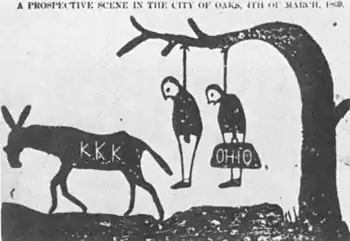
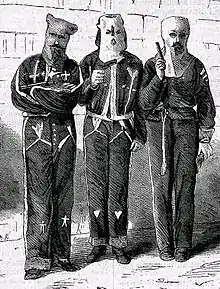
After the Civil War, nearly four million slaves were emancipated in the South. They constituted a majority in some states, and in numerous counties in several states. The first Ku Klux Klan was founded in 1866 by confederate veterans in Tennessee; chapters were formed by armed veterans throughout the South. Members were associated with insurgent violence against freedmen and their allies that included lynchings, but it more often consisted of direct, isolated attacks by secret groups against individuals. The first severe period of violence in the South was between 1868 and 1871. White Democrats attacked black and white Republicans to suppress their voting in elections.[38] To prevent ratification of new constitutions formed during Reconstruction, the opposition used various means to harass potential voters. Failed attacks led to a massacre during the 1868 elections, with the insurgents' murders of about 1,300 voters across various southern states ranging from South Carolina to Arkansas.
The lynchers sometimes murdered their victims, but sometimes whipped or physically assaulted them to remind them of their former status as slaves.[39] Often night-time raids of African-American homes were made in order to confiscate firearms. Lynchings to prevent freedmen and their allies from voting and bearing arms were extralegal ways of trying to enforce the previous system of social dominance and the Black Codes, which had been invalidated by the 14th and 15th Amendments in 1868 and 1870.
Although some states took action against the Klan, the South needed federal help. President Ulysses S. Grant and Congress passed the Enforcement Acts of 1870 and the Civil Rights Act of 1871, also known as the Ku Klux Klan Act, intended to suppress the vigilante violence of the Klan. This authorized the government to prosecute crimes committed by groups such as the Klan, as well as the use of federal troops to control violence. The administration began holding grand juries and prosecuting Klan members. In addition, it used martial law in some counties in South Carolina, where the Klan was the strongest.[40] Under attack, the Klan dissipated. Vigorous federal action and the disappearance of the Klan had a strong effect in temporarily reducing the numbers of murders.[40]
From the mid-1870s onward, violence rose as insurgent paramilitary groups in the Deep South worked to suppress black voting and turn Republicans out of office. In Louisiana, the Carolinas, and Florida especially, the Democratic Party relied on paramilitary "White Line" groups, such as the White Camelia, White League and Red Shirts to terrorize, intimidate and assassinate African-American and white Republicans in an organized drive to regain power. In Mississippi and the Carolinas, paramilitary chapters of Red Shirts conducted overt violence and disruption of elections. In Louisiana, the White League had numerous chapters; they carried out goals of the Democratic Party to suppress black voting. Grant's desire to keep Ohio in the Republican aisle and his attorney general's maneuvers led to a failure to support the Mississippi governor with Federal troops.[41] The campaign of terror worked. In Yazoo County, Mississippi, for instance, with an African-American population of 12,000, only seven votes were cast for Republicans in 1874. In 1875, Democrats swept into power in the Mississippi state legislature.[41]
Once Democrats regained power in Mississippi, Democrats in other states adopted the Mississippi Plan to control the election of 1876, using informal armed militias to assassinate political leaders, hunt down community members, intimidate and turn away voters, and effectively suppress black suffrage and civil rights. In state after state, Democrats swept back to power.[42] From 1868 to 1876, there were 50–100 lynchings annually.
Disenfranchisement (1877–1917)
| Part of a series on the |
| Nadir of American race relations |
|---|
.jpg.webp) |
Following white Democrats' regaining political power in the late 1870s and the end of Reconstruction, legislators gradually increased statutory barriers to voter registration and voting. From 1890 to 1908, most of the Southern states, starting with Mississippi, created new constitutions with further provisions: poll taxes, literacy and understanding tests, and increased residency requirements, that effectively disfranchised most blacks and many poor whites. Forcing them off voter registration lists also prevented them from serving on juries, whose members were limited to voters. Although challenges to such constitutions made their way to the Supreme Court in Williams v. Mississippi (1898) and Giles v. Harris (1903), the states' provisions were upheld.
Most lynchings from the late 19th through the early 20th century were of African Americans in the South.[11][43] Other victims included white immigrants, and, in the Southwest, Latinos. Of the 468 lynching victims in Texas between 1885 and 1942, 339 were black, 77 white, 53 Hispanic, and 1 Native American.[44]
The murders reflected the tensions of labor and social changes, as the whites imposed Jim Crow rules, legal segregation and white supremacy. The lynchings were also an indicator of long economic stress due to falling cotton prices through much of the 19th century, as well as financial depression in the 1890s. In the Mississippi bottomlands, for instance, lynchings rose when crops and accounts were supposed to be settled.[10]
In the Mississippi Delta region
The late 1800s and early 1900s in the Mississippi Delta showed both frontier influence and actions directed at repressing African Americans. After the Civil War, 90% of the Delta was still undeveloped.[10] Both whites and blacks migrated there for a chance to buy land in the backcountry. It was frontier wilderness, heavily forested and without roads for years.[10] Before the start of the 20th century, lynchings often took the form of frontier justice directed at transient workers as well as residents.[10] Thousands of workers were brought in by planters to do lumbering and work on levees.
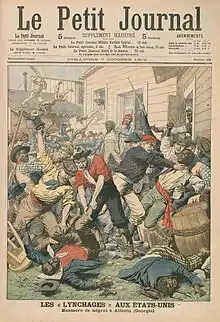
Whites accounted for just over 12 percent of the Delta region's population, but made up nearly 17 percent of lynching victims. So, in this region, they were lynched at a rate that was over 35 percent higher than their proportion in the population, primarily due to being accused of crimes against property (chiefly theft). Conversely, blacks were lynched at a rate, in the Delta, lesser than their proportion of the population. However, this was unlike the rest of the South, where blacks comprised the majority of lynching victims. In the Delta, they were most often accused of murder or attempted murder, in half the cases, and 15 percent of the time, they were accused of rape, meaning that another 15 percent of the time they were accused of a combination of rape and murder, or rape and attempted murder.[10]
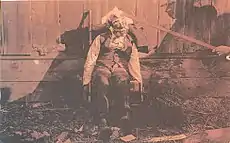
A clear seasonal pattern to lynchings existed with colder months being the deadliest. As noted, cotton prices fell during the 1880s and 1890s, increasing economic pressures. "From September through December, the cotton was picked, debts were revealed, and profits (or losses) realized... Whether concluding old contracts or discussing new arrangements, [landlords and tenants] frequently came into conflict in these months and sometimes fell to blows."[10] During the winter, murder was most cited as a cause for lynching. After 1901, as economics shifted and more blacks became renters and sharecroppers in the Delta, with few exceptions, only African Americans were lynched. The frequency increased from 1901 to 1908 after African Americans were disfranchised. "In the twentieth century Delta vigilantism finally became predictably joined to white supremacy."[46]
Conclusions of numerous studies since the mid-20th century have found the following variables affecting the rate of lynchings in the South: "lynchings were more numerous where the African American population was relatively large, the agricultural economy was based predominantly on cotton, the white population was economically stressed, the Democratic Party was stronger, and multiple religious organizations competed for congregants."[47]
Other ethnicities
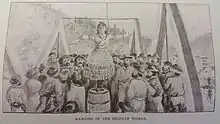
According to the Tuskegee Institute, of the 4,743 people lynched between 1882 and 1968, 1,297 were listed as "white". The Tuskegee Institute, which kept the most complete records, documented victims internally as "Negro", "white", "Chinese", and occasionally as "Mexican" or "Indian", but merged these into only two categories of black or white in the tallies it published. Mexican, Chinese, and Native American lynching victims were tallied as white. Particularly in the West, minorities such as Chinese, Native Americans, Mexicans, and others were also lynching victims. The lynching of Mexicans and Mexican Americans in the Southwest was long overlooked in American history, when attention was focused on the treatment of African Americans in the South.[48][49][23]
In modern scholarship, researchers estimate that 597 Mexicans were lynched between 1848 and 1928. Mexicans were lynched at a rate of 27.4 per 100,000 of population between 1880 and 1930. This statistic was second only to that of the African-American community, which endured an average of 37.1 per 100,000 of population during that period. Between 1848 and 1879, Mexicans were lynched at an unprecedented rate of 473 per 100,000 of population.[23]
After their increased immigration to the U.S. in the late 19th century, Italian Americans in the South were recruited for laboring jobs. On March 14, 1891, 11 Italian immigrants were lynched in New Orleans, Louisiana, for their alleged role in the murder of David Hennessy, an ethnic Irish New Orleans police chief.[50] This incident was one of the largest mass lynchings in U.S. history.[51] A total of twenty Italians were lynched during the 1890s. Although most lynchings of Italian Americans occurred in the South, Italians did not comprise a major portion of immigrants or a major portion of the population as a whole. Isolated lynchings of Italians also occurred in New York, Pennsylvania, and Colorado.
On February 21, 1909, a riot targeting Greek Americans occurred in Omaha, Nebraska. Many Greeks were looted, beaten and businesses were burnt.
Between the 1830s and 1850s the majority of those lynched were whites. More whites were lynched than blacks for the years 1882–1885. By 1890s, the number of blacks lynched yearly grew to a number significantly more than that of whites and vast majority of victims were black from then on. White people were mostly lynched in the Western states and territories, although there were over 200 cases in the South. According to the Tuskegee Institute, in 1884 near Georgetown, Colorado, there was one instance of 17 "unknown white men" being hanged as cattle thieves in a single day. In the West, lynchings were often done to establish law and order.[52][11][53]
Enforcing Jim Crow
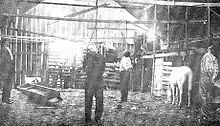
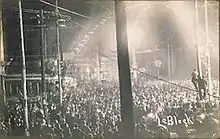

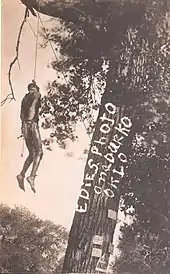
After 1876, the frequency of lynching decreased somewhat until the later 19th century. White Democrats had regained political control of the state legislatures. Lynching was extrajudicial punishment, used by the society to terrorize freedmen and whites alike. Southern Republicans in Congress sought to protect black voting rights by using Federal troops for enforcement. But a congressional deal to elect Ohio Republican Rutherford B. Hayes as President in 1876 (in spite of his losing the popular vote to New York Democrat Samuel J. Tilden) included a pledge to remove Federal troops from the South. The Redeemers, many of whom had been members of such paramilitary groups as the White Cappers, the Knights of the White Camelia, the White League, and the Red Shirts, which supported white Democrats, had used terrorist violence and assassinations in order to suppress black and Republican voting and regain control of the state legislatures.
Lynchings were public demonstrations of white power and a means to exert social control. Racial tensions had an economic base. In attempting to reconstruct the plantation economy, planters were anxious to control labor. In addition, agricultural depression was widespread, and the price of cotton kept falling after the Civil War into the 1890s. A labor shortage occurred in many parts of the Deep South, most especially in the Mississippi Delta, which was being rapidly developed for agriculture. Southern attempts to recruit immigrant labor were unsuccessful, as immigrants would quickly leave field labor. Lynchings erupted when farmers tried to terrorize the laborers, especially when time came to settle and they were unable to pay wages, but tried to keep laborers from leaving.
More than 85 percent of the estimated 5,000 lynchings in the post–Civil War period occurred in the Southern states. With economic strains across the Deep South and a low price for cotton, 1892 was a peak year when 161 African Americans were lynched. The passage of Jim Crow laws, beginning in the 1890s completed the revival of white supremacy in the South. Terror and lynching were believed to be used to enforce both these formal laws and a variety of unwritten rules of conduct meant to assert white domination. In most years from 1889 to 1923, 50 to 100 lynchings occurred annually across the South. They were at a peak in the last decade of the 19th century, but remained high for years.
The frequency of lynchings rose during years of poor economy and low prices for cotton, demonstrating that more than social tensions generated the catalysts for mob action against the underclass.[5] Researchers have studied various models to determine what motivated lynchings. One study of lynching rates of blacks in Southern counties between 1889 and 1931 found a relation to the concentration of blacks in parts of the Deep South: where the black population was concentrated, lynching rates were higher. Such areas also had a particular mix of socioeconomic conditions, with a high dependence on cotton cultivation.[57]
The stated ideology of whites about lynching was directly connected with denial of political and social equality, and sexual fears of white men; it was expressed by Benjamin Tillman, a South Carolina governor and U.S. Senator, speaking on the floor of the Senate in 1900:
We of the South have never recognized the right of the negro to govern white men, and we never will. We have never believed him to be the equal of the white man, and we will not submit to his gratifying his lust on our wives and daughters without lynching him.[58]
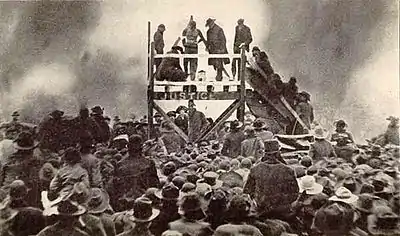
Henry Smith, an alcoholic African-American handyman accused of murdering a policeman's daughter, was a noted lynching victim because of the ferocity of the attack against him and the huge crowd that gathered.[59] He was lynched at Paris, Texas, in 1893 for killing Myrtle Vance, the three-year-old daughter of a Texas policeman, after the policeman had assaulted Smith.[60] Smith was not tried in a court of law. A large crowd followed the lynching, as was common then in the style of public executions. Henry Smith was fastened to a wooden platform, tortured for 50 minutes by red-hot iron brands, and burned alive while more than 10,000 spectators cheered.[59]
Fewer than one percent of lynch mob participants were ever convicted by local courts and they were seldom prosecuted or brought to trial. By the late 19th century, trial juries in most of the southern United States were all white because African Americans had been disenfranchised, and only registered voters could serve as jurors. Often juries never let the matter go past the inquest.
Such cases happened in the North as well. In 1892, a police officer in Port Jervis, New York, tried to stop the lynching of a black man who had been wrongfully accused of assaulting a white woman. The mob responded by putting the noose around the officer's neck as a way of scaring him, and completed killing the other man. Although at the inquest the officer identified eight people who had participated in the lynching, including the former chief of police, the jury determined that the murder had been carried out "by person or persons unknown".[61]

In Duluth, Minnesota, on June 15, 1920, three young African-American traveling circus workers were lynched after having been accused of having raped a white woman and were jailed pending a grand jury hearing. A physician's subsequent examination of the woman found no evidence of rape or assault. The alleged motive and action by a mob were consistent with the "community policing" model.[62]
Although the rhetoric surrounding lynchings frequently suggested they were to protect the virtue and safety of white women, the actions basically arose out of white attempts to maintain domination in a rapidly changing society and their fears of social change.[53] Victims were the scapegoats for peoples' attempts to control agriculture, labor, and education, as well as a reaction to economic stresses during downturns when cotton prices dropped, and larger disasters such as the boll weevil.
According to a Time magazine article, April 2, 2000:
There were lynchings in the Midwestern and Western states, mostly of Asians, Mexicans, and Native Americans. But it was in the South that lynching evolved into a semiofficial institution of racial terror against blacks. All across the former Confederacy, blacks who were suspected of crimes against whites—or even "offenses" no greater than failing to step aside for a white man's car or protesting a lynching—were tortured, hanged and burned to death by the thousands. In a prefatory essay in Without Sanctuary, historian Leon F. Litwack writes that between 1882 and 1968, at least 4,742 African Americans were murdered that way.
In 1903, the St. Louis Post-Dispatch reported a new, popular children's game: "The Game of Lynching". "Imaginary mayor gives order not to harm imaginary mob, and an imaginary hanging follows. Fire contributes realistic touch." "It has crowded out baseball", and if it continues, "may deprive of some of its prestige the game of football."[63]
Photographic records and postcards
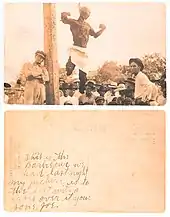
At the start of the 20th century in the United States, lynching was photographic sport. People sent picture postcards of lynchings they had witnessed. A writer for Time magazine noted in 2000,
Even the Nazis did not stoop to selling souvenirs of Auschwitz, but lynching scenes became a burgeoning subdepartment of the postcard industry. By 1908, the trade had grown so large, and the practice of sending postcards featuring the victims of mob murderers had become so repugnant, that the U.S. Postmaster General banned the cards from the mails.[68]
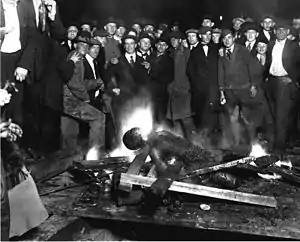
In the post–Reconstruction era South, lynching photographs were printed for various purposes, including postcards, newspapers and event mementos.[69] Typically these images depicted an African-American lynching victim and all or part of the crowd in attendance. Spectators often included women and children. The perpetrators of lynchings were not identified.[70] At one particular lynching, it is said that nearly 15,000 people were in attendance.[69] Often lynchings were advertised in newspapers prior to the event in order to give photographers time to arrive early and prepare their camera equipment.[71] After the lynching, photographers would sell their pictures as-is or as postcards, sometimes costing as much as fifty cents a piece, or $9, as of 2016.[70]
Though some photographs were sold as plain prints, others contained captions. These captions were either straightforward details—such as the time, date and reasons for the lynching—while others contained polemics or poems with racist or otherwise threatening remarks.[71] An example of this is a photographic postcard attached to the poem "Dogwood Tree," which says: "The negro now/By eternal grace/Must learn to stay in the negro's place/In the Sunny South, the land of the Free/Let the WHITE SUPREME forever be."[72] Such postcards with explicit rhetoric such as "Dogwood Tree" were typically circulated privately or mailed in a sealed envelope.[73] Other times these pictures simply included the word "WARNING".[71]
In 1873, the Comstock Act was passed, which banned the publication of "obscene matter as well as its circulation in the mails".[71] In 1908, Section 3893 was added to the Comstock Act, stating that the ban included material "tending to incite arson, murder, or assassination".[71] Although this act did not explicitly ban lynching photographs or postcards, it banned the explicit racist texts and poems inscribed on certain prints. According to some, these texts were deemed "more incriminating" and caused their removal from the mail instead of the photograph itself because the text made "too explicit what was always implicit in lynchings".[71] Some towns imposed "self-censorship" on lynching photographs, but section 3893 was the first step towards a national censorship.[71] Despite the amendment, the distribution of lynching photographs and postcards continued. Though they were not sold openly, the censorship was bypassed when people sent the material in envelopes or mail wrappers.[73]
In Without Sanctuary (2000), a book of lynching postcards collected by James Allen, Pulitzer Prize-winning historian Leon Litwack wrote:
The photographs stretch our credulity, even numb our minds and senses to the full extent of the horror, but they must be examined if we are to understand how normal men and women could live with, participate in, and defend such atrocities, even reinterpret them so they would not see themselves or be perceived as less than civilized. The men and women who tortured, dismembered, and murdered in this fashion understood perfectly well what they were doing and thought of themselves as perfectly normal human beings. Few had any ethical qualms about their actions. This was not the outburst of crazed men or uncontrolled barbarians but the triumph of a belief system that defined one people as less human than another. For the men and women who composed these mobs, as for those who remained silent and indifferent or who provided scholarly or scientific explanations, this was the highest idealism in the service of their race. One has only to view the self-satisfied expressions on their faces as they posed beneath black people hanging from a rope or next to the charred remains of a Negro who had been burned to death. What is most disturbing about these scenes is the discovery that the perpetrators of the crimes were ordinary people, not so different from ourselves – merchants, farmers, laborers, machine operators, teachers, doctors, lawyers, policemen, students; they were family men and women, good churchgoing folk who came to believe that keeping black people in their place was nothing less than pest control, a way of combating an epidemic or virus that if not checked would be detrimental to the health and security of the community."
Resistance
African Americans emerged from the Civil War with the political experience and stature to resist attacks, but disfranchisement and imposition of Jim Crow in the South at the turn of the 20th century closed them out of the political system and judicial system in many ways. Advocacy organizations compiled statistics and publicized the atrocities, as well as working for enforcement of civil rights and a federal anti-lynching law. From the early 1880s, the Chicago Tribune reprinted accounts of lynchings from other newspapers, and published annual statistics. These provided the main source for the compilations by the Tuskegee Institute to document lynchings, a practice it continued until 1968.[74]
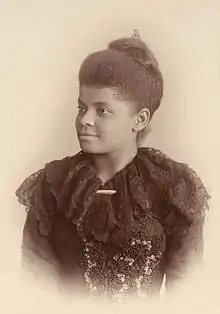
In 1892, journalist Ida B. Wells-Barnett was shocked when three friends in Memphis, Tennessee, were lynched. She learned it was because their grocery store had competed successfully against a white-owned store. Outraged, Wells-Barnett began a global anti-lynching campaign that raised awareness of these murders. She also investigated lynchings and overturned the common idea that they were based on black sexual crimes, as was popularly discussed; she found lynchings were more an effort to suppress blacks who competed economically with whites, especially if they were successful. As a result of her efforts at education, black women in the U.S. became active in the anti-lynching crusade, often in the form of clubs that raised money to publicize the abuses. When the National Association for the Advancement of Colored People (NAACP) was formed in 1909, Wells became part of its multi-racial leadership and continued to be active against lynching. The NAACP began to publish lynching statistics at their office in New York City.
In 1898 Alexander Manly of Wilmington, North Carolina, directly challenged popular ideas about lynching in an editorial in his newspaper The Daily Record. He noted that consensual relationships took place between white women and black men, and said that many of the latter had white fathers (as he did). His references to miscegenation lifted the veil of denial. Whites were outraged. A mob destroyed his printing press and business, ran black leaders out of town and killed many others, and overturned the biracial Populist-Republican city government, headed by a white mayor and majority-white council. Manly escaped, eventually settling in Philadelphia, Pennsylvania.
In 1903, writer Charles W. Chesnutt of Ohio published the article "The Disfranchisement of the Negro", detailing civil rights abuses as Southern states passed laws and constitutions that essentially disenfranchised African Americans, excluding them wholesale from the political system. He publicized the need for change in the South. Numerous writers appealed to the literate public.[75]
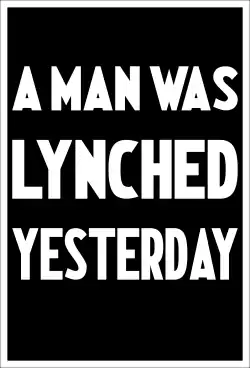
In 1904, Mary Church Terrell, the first president of the National Association of Colored Women, published an article in the magazine North American Review to respond to Southerner Thomas Nelson Page. She analyzed and refuted with data his attempted justification of lynching as a response to assaults by black men on white women. Terrell showed how apologists like Page had tried to rationalize what were violent mob actions that were seldom based on assaults.[76] Africian American newspapers such as the Chicago Illinois Newspaper "The Chicago Whip" [77]and the NAACP magazine The Crisis would not just mearly report lynchings they would denounce them as well. Indeed in 1919 the NAACP would Published "Thirty Years of Lynching" and hang a black flag outside its office.
Federal action limited by the Solid South
In 1900, as the 56th Congress considered proposals for apportioning its seats among the 45 states following the 1900 Federal Census, Representative Edgar D. Crumpacker (R-IN) filed an independent report urging that the Southern states be stripped of seats due to the large numbers of voters they had disfranchised. He noted this was provided for in Section 2 of the Fourteenth Amendment, which provided for stripping representation from states that reduced suffrage due to race.[78] However, concerted opposition of the Southern Democratic bloc was aroused, and the effort failed.
From 1896 until 1900, the House of Representatives with a Republican majority had acted in more than thirty cases to set aside election results from Southern states where the House Elections Committee had concluded that "black voters had been excluded due to fraud, violence, or intimidation". However, in the early 1900s, it began to back off, after Democrats won a majority, which included Southern delegations that were solidly in Democratic hands.
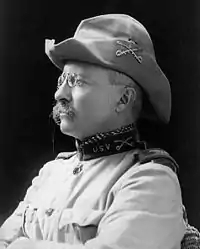
President Theodore Roosevelt made public statements against lynching in 1903, following George White's murder in Delaware, and in the 1906 State of the Union Address on December 4, 1906. When Roosevelt suggested that lynching was taking place in the Philippines, Southern senators (all white Democrats) demonstrated their power by a filibuster in 1902 during review of the "Philippines Bill". In 1903 Roosevelt refrained from commenting on lynching during his Southern political campaigns.
Roosevelt published a letter he wrote to Governor Winfield T. Durbin of Indiana in August 1903, saying:
My Dear Governor Durbin ... permit me to thank you as an American citizen for the admirable way in which you have vindicated the majesty of the law by your recent action in reference to lynching. ... All thoughtful men ... must feel the gravest alarm over the growth of lynching in this country, and especially over the peculiarly hideous forms so often taken by mob violence when colored men are the victims – on which occasions the mob seems to lay more weight, not on the crime but on the color of the criminal. ... There are certain hideous sights which when once seen can never be wholly erased from the mental retina. The mere fact of having seen them implies degradation...Whoever in any part of our country has ever taken part in lawlessly putting to death a criminal by the dreadful torture of fire must forever after have the awful spectacle of his own handiwork seared into his brain and soul. He can never again be the same man.[79]
Durbin had successfully used the Indiana National Guard to disperse lynchers, and publicly declared that an African-American man accused of murder was entitled to a fair trial. Roosevelt's efforts cost him political support among white people, especially in the South. Threats against him increased so that the Secret Service added to the size of his bodyguard detail.[80]
Great Migration
In what has been viewed as multiple acts of resistance, tens of thousands of African Americans left the South annually – especially from 1910 to 1940 – seeking jobs and better lives in industrial cities of the Northeast and Midwest in a movement that was called the "Great Migration".[53] More than 1.5 million people went North during this phase of the Great Migration. They refused to live under the rules of segregation and the continual threat of violence, and many secured better educations and futures for themselves and their children, while adapting to the drastically different requirements of industrial cities. Northern industries such as the Pennsylvania Railroad and others, and stockyards and meatpacking plants in Chicago and Omaha, vigorously recruited southern workers. For instance, by 1923, the Pennsylvania Railroad had hired 10,000 black men from Florida and Georgia to work at their expanding yards and tracks.[81]
The rapid influx of blacks disturbed the racial balance within Northern cities, exacerbating hostility between black and white Northerners. The Red Summer of 1919 was marked by hundreds of deaths and higher casualties across the U.S. as a result of race riots that occurred in more than three dozen cities, such as the Chicago race riot of 1919 and the Omaha race riot of 1919. Stereotypic schemas of Southern blacks were used to attribute issues in urban areas, such as crime and disease, to the presence of African Americans. Overall, African Americans in Northern cities experienced systemic discrimination in a plethora of aspects of life. Within employment, economic opportunities for blacks were routed to the lowest-status and restrictive in potential mobility. Within the housing market, stronger discriminatory measures were used in correlation to the influx, resulting in a mix of "targeted violence, restrictive covenants, redlining and racial steering".[82]
World War I to World War II
Resistance
African-American writers used their talents in numerous ways to publicize and protest against lynching. In 1914, Angelina Weld Grimké had already written her play Rachel to address racial violence. It was produced in 1916. In 1915, W. E. B. Du Bois, noted scholar and head of the recently formed NAACP, called for more black-authored plays.
African-American women playwrights were strong in responding. They wrote ten of the 14 anti-lynching plays produced between 1916 and 1935. The NAACP set up a Drama Committee to encourage such work. In addition, Howard University, the leading historically black college, established a theater department in 1920 to encourage African-American dramatists. Starting in 1924, the NAACP's major publications The Crisis and Opportunity sponsored contests to encourage black literary production.[83]
New Klan
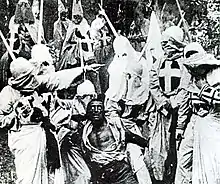
In 1915, three events highlighted racial and social tensions: distribution of D.W. Griffith's film, The Birth of a Nation; the lynching of Leo Frank, a Jewish factory manager, in Atlanta, Georgia; and the revival of the Ku Klux Klan near Atlanta.
D. W. Griffith's 1915 film, The Birth of a Nation, glorified the original Klan as protecting southern women during Reconstruction, which he portrayed as a time of violence and corruption, following the Dunning School interpretation of history. The film aroused great controversy. It was popular among whites in the South, but was protested against by the NAACP and other civil rights groups, who achieved banning it in some cities, and it garnered much national publicity.
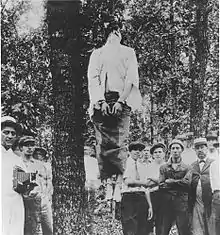
In 1915, Leo Frank, an American Jew, was lynched near Atlanta, Georgia. Frank had been convicted in 1913 for the murder of Mary Phagan, a thirteen-year-old girl employed by his pencil factory. There were a series of appeals, but all failed. The final appeal was a 7-2 decision by the U.S. Supreme Court. After Governor John M. Slaton commuted Frank's sentence to life imprisonment, a group of men, calling themselves the Knights of Mary Phagan, kidnapped Frank from a prison farm in Milledgeville in a planned event that included cutting the prison's telephone wires. They transported him 175 miles back to Marietta, near Atlanta, where they lynched him in front of a mob.
On November 25, 1915, two months after Frank was lynched, a group led by William J. Simmons burned a cross on top of Stone Mountain, inaugurating a revival of the Ku Klux Klan. The event was attended by 15 charter members and a few aging survivors of the original Klan.[84]
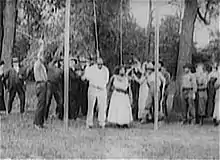
The Klan and their use of lynching was supported by some public officials like John Trotwood Moore, the State Librarian and Archivist of Tennessee from 1919 to 1929.[85] Moore "became one of the South's more strident advocates of lynching."[85]
The Klan grew after that due to majority of white Protestants' anxieties and fears over the rapid pace of change and economic and social competition. It promoted itself as a fraternal organization for ethnic Northern Europeans in new urban environments. Many African-American migrants moved north in the Great Migration, resulting in labor shortages in most of the rural South. In addition, they also migrated to some rapidly growing Southern industrial cities. At the same time, the United States was receiving millions of immigrants from Mexico, the Middle East, East Asia, and southern and eastern Europe who settled in northeastern, midwestern, and western industrial cities. As a result, the Klan grew rapidly and became most successful and strongest in those cities that had a rapid pace of growth from 1910 to 1930, such as southern cities of Atlanta, Georgia; Birmingham, Alabama; and Dallas, Texas; and non-southern cities of Detroit, Michigan; Indianapolis, Indiana; Chicago, Illinois; Portland, Oregon; and Denver, Colorado. It reached a peak of membership and influence about 1925. In some cities, non-Protestant leaders' actions to publish names of Klan members and override its secrecy provided enough publicity to sharply reduce membership.[86]
1919 was one of the worst years for lynching with at least seventy-six people were killed in mob or vigilante related violence. Of these, more than eleven African American veterans who had served in the recently completed war were lynched in that year. [87]:232
Continuing resistance
The NAACP mounted a strong nationwide campaign of protests and public education against The Birth of a Nation. As a result, some city governments prohibited the release of the film. In addition, the NAACP publicized production and helped create audiences for the 1919 releases, The Birth of a Race and Within Our Gates, African-American–directed films that presented more positive images of blacks.
On April 1, 1918, U.S. Representative Leonidas C. Dyer of St. Louis, Missouri, introduced the Dyer Anti-Lynching Bill in the U.S. House of Representatives. Rep. Dyer was concerned over increased lynching, mob violence, and disregard for the "rule of law" in the South. The bill made lynching a federal crime, and those who participated in lynching would be prosecuted by the federal government. It did not pass due to a Southern filibuster, and the Senate would not pass anti-lynching legislation until 2018 (the Justice for Victims of Lynching Act).
On 1919, the new NAACP organized the National Conference on Lynching to increase support for the Dyer Bill.
In 1920, the black community succeeded in getting its most important priority in the Republican Party's platform at the National Convention: support for an anti-lynching bill. The black community supported Warren G. Harding in that election, but were disappointed as his administration moved slowly on a bill.[88]
Dyer revised his bill and re-introduced it to the House in 1921. It passed the House on January 22, 1922, due to "insistent country-wide demand",[88] and was favorably reported out by the Senate Judiciary Committee. Action in the Senate was delayed, and ultimately the Democratic Solid South filibuster defeated the bill in the Senate in December.[89] In 1923, Dyer went on a midwestern and western state tour promoting the anti-lynching bill; he praised the NAACP's work for continuing to publicize lynching in the South and for supporting the federal bill. Dyer's anti-lynching motto was "We have just begun to fight," and he helped generate additional national support. His bill was defeated twice more in the Senate by Southern Democratic filibuster. The Republicans were unable to pass a bill in the 1920s.[90]

African-American resistance to lynching carried substantial risks. In 1921, in Tulsa, Oklahoma, a group of African-American citizens attempted to stop a lynch mob from taking 19-year-old assault suspect Dick Rowland out of jail. In a scuffle between a white man and an armed African-American veteran, the white man was killed. Whites retaliated by rioting, during which they burned 1,256 homes and as many as 200 businesses in the segregated Greenwood district, destroying what had been a thriving area. Confirmed dead were 39 people: 26 African Americans and 13 whites. Recent investigations suggest the number of African-American deaths may have been much higher, up to 300.[91] Rowland was saved, however, and was later exonerated.
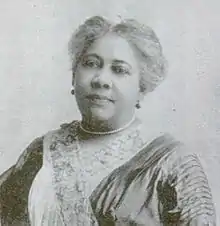
The growing networks of African-American women's club groups were instrumental in raising funds to support the NAACP's public education and lobbying campaigns. They also built community organizations. In 1922, Mary Talbert headed the anti-lynching crusade to create an integrated women's movement against lynching.[76] It was affiliated with the NAACP, which mounted a multi-faceted campaign. For years the NAACP used petition drives, letters to newspapers, articles, posters, lobbying Congress, and marches to protest against the abuses in the South and keep the issue before the public.
While the second Ku Klux Klan grew rapidly in cities, underwent major change, and achieved some political power, many state and city leaders, including white religious leaders such as Reinhold Niebuhr in Detroit, acted strongly and spoke out publicly against the organization. Some anti-Klan groups published members' names and quickly reduced the energy in their efforts. As a result, in most areas, after 1925 Klan membership and organizations rapidly declined. Cities passed laws against wearing of masks, and otherwise acted against the Klan.[92]
In 1930, Southern white women responded in large numbers to the leadership of Jessie Daniel Ames in forming the Association of Southern Women for the Prevention of Lynching. She and her co-founders obtained the signatures of 40,000 women to their pledge against lynching and for a change in the South. The pledge included the statement:
In light of the facts we dare no longer to... allow those bent upon personal revenge and savagery to commit acts of violence and lawlessness in the name of women.
Despite physical threats and hostile opposition, the women leaders persisted with petition drives, letter campaigns, meetings, and demonstrations to highlight the issues.[15] By the 1930s, the number of lynchings had dropped to about ten per year in Southern states.
In the 1930s, communist organizations, including a legal defense organization called the International Labor Defense (ILD), organized support to stop lynching (see Communist Party USA and African Americans). The ILD defended the Scottsboro Boys, as well as three black men accused of rape in Tuscaloosa in 1933. In the Tuscaloosa case, two defendants were lynched under circumstances that suggested police complicity. The ILD lawyers narrowly escaped lynching. Many Southerners resented them for their perceived "interference" in local affairs. In a remark to an investigator, a white Tuscaloosan said, "For New York Jews to butt in and spread communistic ideas is too much."[39]
Federal action and Southern resistance
Anti-lynching advocates such as Mary McLeod Bethune and Walter Francis White campaigned for presidential candidate Franklin D. Roosevelt in 1932. They hoped he would lend public support to their efforts against lynching. Senators Robert F. Wagner and Edward P. Costigan drafted the Costigan–Wagner Bill in 1934 to require local authorities to protect prisoners from lynch mobs. Like the Dyer Bill, it made lynching a Federal crime in order to take it out of state administration.
Southern Senators continued to hold a hammerlock on Congress. Because of the Southern Democrats' disfranchisement of African Americans in Southern states at the start of the 20th century, Southern whites for decades had nearly double the representation in Congress beyond their own population. Southern states had Congressional representation based on total population, but essentially only whites could vote and only their issues were supported. Due to seniority achieved through one-party Democratic rule in their region, Southern Democrats controlled many important committees in both houses. Southern Democrats consistently opposed any legislation related to putting lynching under Federal oversight. As a result, Southern white Democrats were a formidable power in Congress until the 1960s.
In the 1930s, virtually all Southern senators blocked the proposed Costigan–Wagner Bill. Southern senators used a filibuster to prevent a vote on the bill. Some Republican senators, such as the conservative William Borah from Idaho, opposed the bill for constitutional reasons (he had also opposed the Dyer Bill). He felt it encroached on state sovereignty and, by the 1930s, thought that social conditions had changed so that the bill was less needed.[93] He spoke at length in opposition to the bill in 1935 and 1938. 1934 saw 15 lynchings of African Americans with 21 lynchings in 1935, 8 in 1936, and 2 in 1939.
A lynching in Fort Lauderdale, Florida, changed the political climate in Washington.[94] On July 19, 1935, Rubin Stacy, a homeless African-American tenant farmer, knocked on doors begging for food. After resident complaints, deputies took Stacy into custody. While he was in custody, a lynch mob took Stacy from the deputies and murdered him. Although the faces of his murderers could be seen in a photo taken at the lynching site, the state did not prosecute the murder.[95]
Stacy's murder galvanized anti-lynching activists, but President Roosevelt did not support the federal anti-lynching bill. He feared that support would cost him Southern votes in the 1936 election. He believed that he could accomplish more for more people by getting re-elected.
In 1937, the lynching of Roosevelt Townes and Robert McDaniels gained national publicity, and its brutality was widely condemned.[96] Such publicity enabled Joseph A. Gavagan (D-New York) to gain support for anti-lynching legislation he had put forward in the House of Representatives; it was supported in the Senate by Democrats Robert F. Wagner (New York) and Frederick Van Nuys (Indiana). The legislation eventually passed in the House, but the Solid South of white Democrats blocked it in the Senate.[97][98]
In 1939, Roosevelt created the Civil Rights Section of the Justice Department. It started prosecutions to combat lynching, but failed to win any convictions until 1946.[99]
World War II to the present
Second Great Migration
The industrial buildup to World War II acted as a "pull" factor in the second phase of the Second Great Migration starting in 1940 and lasting until 1970. Altogether in the first half of the 20th century, 6.5 million African Americans migrated from the South to leave lynchings and segregation behind. Unlike the first round, composed chiefly of rural farmworkers, the second wave included more educated workers and their families who were already living in Southern cities and towns. In this migration, many left for Western cities in addition to Northeastern and Midwestern cities, as defense industries recruited tens of thousands to higher-paying, skilled jobs. They settled in Los Angeles, San Francisco, Oakland, Phoenix, Portland, and Seattle.
Federal action
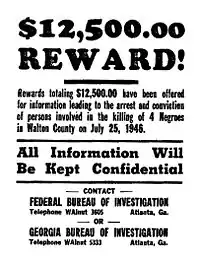
In 1946, the Civil Rights Section of the Justice Department gained its first conviction under federal civil rights laws against a lyncher. Florida constable Tom Crews was sentenced to a $1,000 fine (equivalent to $13,100 in 2019) and one year in prison for civil rights violations in the killing of an African-American farm worker.
In 1946, a mob of white men shot and killed two young African-American couples near Moore's Ford Bridge in Walton County, Georgia, 60 miles east of Atlanta. This lynching of four young sharecroppers, one a World War II veteran, shocked the nation. The attack was a key factor in President Harry S. Truman's making civil rights a priority of his administration. Although the Federal Bureau of Investigation (FBI) investigated the crime, they were unable to prosecute. It was the last documented lynching of so many people in one incident.[99]
In 1947, the Truman administration published a report entitled To Secure These Rights which advocated making lynching a federal crime, abolishing poll taxes, and other civil rights reforms. The Southern Democratic bloc of senators and congressmen continued to obstruct attempts at federal legislation.[100]
In the 1940s, the Klan openly criticized Truman for his efforts to promote civil rights. Later historians documented that Truman had briefly made an attempt to join the Klan as a young man in 1924, when it was near its peak of social influence in promoting itself as a fraternal organization. When a Klan officer demanded that Truman pledge not to hire any Catholics if he were re-elected as county judge, Truman refused. He personally knew their worth from his World War I experience. His membership fee was returned and he never joined the Klan.[101]
Lynching and the Cold War
International media, including the media in the Soviet Union, covered racial discrimination in the U.S.[45][102] Deeming American criticism of the Soviet Union's human rights abuses as hypocrisy, the Soviets would respond with "And you are lynching Negroes".[103] In his 1934 book Russia Today: What Can We Learn from It?, Sherwood Eddy wrote: "In the most remote villages of Russia today Americans are frequently asked what they are going to do to the Scottsboro Boys and why they lynch Negroes."[104]
In a meeting with President Harry Truman in 1946, Paul Robeson urged him to take action against lynching. In 1951, Robeson and the Civil Rights Congress made a presentation entitled "We Charge Genocide" to the United Nations. They argued that the U.S. government was guilty of genocide under Article II of the United Nations Genocide Convention because it failed to act against lynchings. The first year on record with no lynchings reported in the United States was 1952.[105]
In the early Cold War years, the FBI was worried more about possible communist connections among anti-lynching groups than about the lynching crimes. For instance, the FBI branded Albert Einstein a communist sympathizer for joining Robeson's American Crusade Against Lynching.[106] J. Edgar Hoover, head of the FBI for decades, was particularly fearful of the effects of communism in the United States. He directed more attention to investigations of civil rights groups for communist connections than to Ku Klux Klan activities against the groups' members and other innocent blacks.
Civil rights movement
By the 1950s, the civil rights movement was gaining momentum. Membership in the NAACP increased in states across the country. The NAACP achieved a significant U.S. Supreme Court victory in 1954 ruling that segregated education was unconstitutional. A 1955 lynching that sparked public outrage about injustice was that of Emmett Till, a 14-year-old boy from Chicago. Spending the summer with relatives in Money, Mississippi, Till was killed for allegedly having wolf-whistled at a white woman. Till had been badly beaten, one of his eyes was gouged out, and he was shot in the head before being thrown into the Tallahatchie River, his body weighed down with a 70-pound (32 kg) cotton gin fan tied around his neck with barbed wire. His mother insisted on a public funeral with an open casket, to show people how badly Till's body had been disfigured. News photographs circulated around the country, and drew intense public reaction. The visceral response to his mother's decision to have an open-casket funeral mobilized the black community throughout the U.S.[107] The state of Mississippi tried two defendants, but they were speedily acquitted by an all-white jury.[108]
In the 1960s the civil rights movement attracted students to the South from all over the country to work on voter registration and integration. The intervention of people from outside the communities and threat of social change aroused fear and resentment among many whites. In June 1964, three civil rights workers disappeared in Neshoba County, Mississippi. They had been investigating the arson of a black church being used as a "Freedom School". Six weeks later, their bodies were found in a partially constructed dam near Philadelphia, Mississippi. James Chaney of Meridian, Mississippi, and Michael Schwerner and Andrew Goodman of New York City had been members of the Congress of Racial Equality. They had been dedicated to non-violent direct action against racial discrimination. The investigation also unearthed the bodies of numerous anonymous victims of past lynchings and murders.
The United States prosecuted 18 men for a Ku Klux Klan conspiracy to deprive the victims of their civil rights under 19th-century Federal law, in order to prosecute the crime in Federal court. Seven men were convicted but received light sentences, two men were released because of a deadlocked jury, and the remainder were acquitted. In 2005, 80-year-old Edgar Ray Killen, one of the men who had earlier gone free, was retried by the state of Mississippi, convicted of three counts of manslaughter in a new trial, and sentenced to 60 years in prison. Killen died in 2018 after serving 12 1⁄2 years.
Because of J. Edgar Hoover's and others' hostility to the civil rights movement, agents of the FBI resorted to outright lying to smear civil rights workers and other opponents of lynching. For example, the FBI leaked false information in the press about the lynching victim Viola Liuzzo, who was murdered in 1965 in Alabama. The FBI said Liuzzo had been a member of the Communist Party USA, had abandoned her five children, and was involved in sexual relationships with African Americans in the movement.[109]
After the civil rights movement
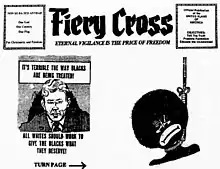
Incidents
Although lynchings have become rare following the civil rights movement and changing social norms, some lynchings have still occurred. In 1981, two Klan members in Alabama randomly selected a 19-year-old black man, Michael Donald, and murdered him, in order to retaliate for a jury's acquittal of a black man who was accused of murdering a white police officer. The Klansmen were caught, prosecuted, and convicted (one of the Klansmen, Henry Hayes, was sentenced to death and executed on June 6, 1997). A $7 million judgment in a civil suit against the Klan bankrupted the local Klan subgroup, the United Klans of America.[110]
In 1998, Shawn Allen Berry, Lawrence Russel Brewer, and ex-convict John William King murdered James Byrd, Jr. in Jasper, Texas. Byrd was a 49-year-old father of three, who had accepted an early-morning ride home with the three men. They attacked him and dragged him to his death behind their truck.[111] The three men dumped their victim's mutilated remains in the town's segregated African-American cemetery and then went to a barbecue.[112] Local authorities immediately treated the murder as a hate crime and requested FBI assistance. The murderers (two of whom turned out to be members of a white supremacist prison gang) were caught and stood trial. Brewer and King were both sentenced to death (with Brewer being executed in 2011, and King being executed in 2019). Berry was sentenced to life in prison.
On June 13, 2005, the U.S. Senate formally apologized for its failure to enact a federal anti-lynching law in the early 20th century, "when it was most needed". Before the vote, Louisiana senator Mary Landrieu noted: "There may be no other injustice in American history for which the Senate so uniquely bears responsibility."[113] The resolution was passed on a voice vote with 80 senators cosponsoring, with Mississippians Thad Cochran and Trent Lott being among the twenty U.S. senators abstaining.[113] The resolution expressed "the deepest sympathies and most solemn regrets of the Senate to the descendants of victims of lynching, the ancestors of whom were deprived of life, human dignity and the constitutional protections accorded all citizens of the United States".[113]
In February 2014 a noose was placed on the statue of James Meredith, the first African-American student at the University of Mississippi.[114] A number of nooses appeared in 2017, primarily in or near Washington, D.C.[115][116][117]
In August 2014 Lennon Lacy, a teenager from Bladenboro, North Carolina, who had been dating a white girl, was found dead, hanging from a swing set. His family believes he was lynched, but the FBI stated, after investigation, that it found no evidence of a hate crime. The case is featured in a 2019 documentary about lynching in America, Always in Season.[118]
In May 2017, Mississippi state representative Karl Oliver of Winona stated that Louisiana lawmakers who supported the removal of Confederate monuments from their state should be lynched. Oliver's district includes Money, Mississippi, where Emmett Till was murdered. Mississippi leaders from both the Republican and Democratic parties quickly condemned Oliver's statement.[119]
In 2019, Goodloe Sutton, then editor of a small Alabama newspaper, The Democrat-Reporter, got national publicity by saying in an editorial that the Ku Klux Klan was needed to "clean up D.C."[120] Asked what he meant by "cleaning up D.C.", he suggested lynching: "We'll get the hemp ropes out, loop them over a tall limb and hang all of them." "When asked if he felt it was appropriate for the publisher of a newspaper to call for the lynching of Americans, Sutton doubled down on his position: …'It's not calling for the lynchings of Americans. These are socialist-communists we're talking about. Do you know what socialism and communism is?'" He denied that the Klan was a racist and violent organization, comparing it to the NAACP.[121]
On January 6, 2021 the rioters during the 2021 Storming of the United States Capitol shouted "Hang Mike Pence!" in an attempt to lynch the Vice-President for refusing to overturn the 2020 United States Presidential Election in favor of President Donald Trump.[122]
Legislation
On June 30, 2018, three senators (Kamala Harris, Cory Booker, and Tim Scott) introduced the Justice for Victims of Lynching Act to make lynching a Federal hate crime.[123] The Senate voted unanimously in favor of it on December 19, 2018.[124][125] However, the bill died because it was not passed by the House before the 115th Congress ended on January 3, 2019.[126]
Sponsored by Bobby Rush, the U.S. House of Representatives passed the Emmett Till Antilynching Act by a vote of 410–4 on February 26, 2020, designating the act of lynching as a hate crime. During the floor debate, Rush said the bill's passage would "send a strong message that violence, and race-based violence in particular, has no place in American society."[127] The bill was reported out of the House Judiciary Committee on October 31, 2019, and was passed by the House, 410-4, on February 26, 2020.[128]
As of June 4, 2020, while protests and civil unrest over the killing of George Floyd were occurring nationwide, the bill was being considered by the Senate, with Senator Rand Paul preventing the bill from being passed by unanimous consent. Paul opposes the bill's language for being overly broad, including attacks which he felt were not extreme enough to qualify as "lynching", stating that "this bill would cheapen the meaning of lynching by defining it so broadly as to include a minor bruise or abrasion" and has proposed an amendment that would apply a "serious bodily injury standard" for a crime to be considered as lynching.[129][130][131]
House Majority Leader Steny Hoyer criticized Rand Paul's position, saying on Twitter that "it is shameful that one GOP Senator is standing in the way of seeing this bill become law." Senator Kamala Harris added that "Senator Paul is now trying to weaken a bill that was already passed — there's no reason for this" while speaking to have the amendment defeated.[131][129]
As of November 17, 2020, no legislation has passed both houses of Congress.
Effects
A 2017 study found that exposure to lynchings in the post-Reconstruction South "reduced local black voter turnout by roughly 2.5 percentage points."[132] Another 2017 study found supportive evidence of Stewart Tolnay and E. M. Beck's claim that lynchings were "due to economic competition between African-American and white cotton workers".[133] The study found that lynchings were associated with greater black out-migration from 1920 to 1930, and higher state-level wages.[133] A 2014 study by economist Lisa D. Cook found that lynchings and other forms of racial violence targeting African Americans over the period 1870–1940 to lower innovation among African Americans.[134]
Statistics
Statistics for lynchings have traditionally come from three sources primarily, none of which covered the entire historical time period of lynching in the United States. Before 1882, no reliable statistics are assembled on a national level. In 1882, the Chicago Tribune began to systematically tabulate lynchings. In 1908, the Tuskegee Institute began a systematic collection of lynching reports under the direction of Monroe Work at its Department of Records, drawn primarily from newspaper reports. Monroe Work published his first independent tabulations in 1910, although his report also went back to the starting year 1882.[135] Finally, in 1912, the National Association for the Advancement of Colored People started an independent record of lynchings. The numbers of lynchings from each source vary slightly, with the Tuskegee Institute's figures being considered "conservative" by some historians.[53]
Tuskegee Institute, now Tuskegee University, defined conditions that constituted a recognized lynching, a definition which became generally accepted by other compilers of the era:
There must be legal evidence that a person was killed. That person must have met death illegally. A group of three or more persons must have participated in the killing. The group must have acted under the pretext of service to Justice, Race, or Tradition."
The records of Tuskegee Institute remain the single most complete source of statistics and records on this crime since 1882 for all states, although modern research has illuminated new incidents in studies focused on specific states in isolation.[136] As of 1959, which was the last time that Tuskegee Institute's annual report was published, a total of 4,733 persons had died by lynching since 1882. To quote the report,
Except for 1955, when three lynchings were reported in Mississippi, none has been recorded at Tuskegee since 1951. In 1945, 1947, and 1951, only one case per year was reported. The most recent case reported by the institute as a lynching was that of Emmett Till, 14, a Negro who was beaten, shot to death, and thrown into a river at Greenwood, Mississippi on August 28, 1955...For a period of 65 years ending in 1947, at least one lynching was reported each year. The most for any year was 231 in 1892. From 1882 to 1901, lynchings averaged more than 150 a year. Since 1924, lynchings have been in a marked decline, never more than 30 cases, which occurred in 1926..."[137]
1892 was the most common year for lynching, with a rate of 3.25 per a million people. Lynchings were most common in the latter 19th century and greatly reduced following the 1920s.[48][52] The decreasing rate of yearly lynchings was faster outside the South and for white victims of lynching. Lynching became more of a Southern phenomenon and a racial one that overwhelmingly affected black victims.[138]
Opponents of legislation often said lynchings prevented murder and rape. As documented by Ida B. Wells, the most prevalent accusation against lynching victims was murder or attempted murder. Rape charges or rumors were present in less than one-third of the lynchings; such charges were often pretexts for lynching blacks who violated Jim Crow etiquette or engaged in economic competition with whites. Other common reasons given included arson, theft, assault, and robbery; sexual transgressions (miscegenation, adultery, cohabitation); "race prejudice", "race hatred", "racial disturbance;" informing on others; "threats against whites;" and violations of the color line ("attending white girl", "proposals to white woman").[139]
1892. According to the Tuskegee Institute, 38% of victims of lynching were accused of murder, 16% of rape, 7% for attempted rape, 6% were accused of felonious assault, 7% for theft, 2% for insult to white people and 24% were accused of miscellaneous offenses or no offense.[138]
In 1940, Sociologist Arthur F. Raper investigated one hundred lynchings after 1929 and estimated that approximately one-third of the victims were falsely accused.[138]
Tuskegee Institute's method of categorizing most lynching victims as either black or white in publications and data summaries meant that the murders of some minority and immigrant groups were obscured. In the West, for instance, Mexican, Native Americans, and Chinese were more frequent targets of lynchings than were African Americans, but their deaths were included among those of whites. Similarly, although Italian immigrants were the focus of violence in Louisiana when they started arriving in greater numbers, their deaths were not tabulated separately from whites. In earlier years, whites who were subject to lynching were often targeted because of suspected political activities or support of freedmen, but they were generally considered members of the community in a way new immigrants were not.[23]
There were also black-on-black lynchings, with 125 recorded between 1882 and 1903, and there were four incidences of whites being killed by black mobs. The rate of black-on-black lynchings rose and fell in similar pattern of overall lynchings. There were also over 200 cases of white-on-white lynchings in the South before 1930.[52]
The Equal Justice Initiative in Montgomery, Alabama, reported 3,959 American victims of "racial terror lynchings" in 12 Southern states from 1877 to 1950, and also provided a map of the murders.[140]
Representation in popular culture
Literature and film
- Mark Twain's Adventures of Huckleberry Finn, an 1885 novel, depicts attempted (although failed) lynching as a minor episode.
- Owen Wister's The Virginian, a 1902 seminal novel in the genre of Western novels in the United States, dealt with a fictional treatment of the Johnson County War and frontier lynchings in the West.
- Tracked by Bloodhounds; or, A Lynching at Cripple Creek, a 1904 silent crime drama short film directed by Harry Buckwalter.
- Angelina Weld Grimké's Rachel (1914) was the first play about the toll of racial violence directed at African-American families; it was produced in 1916.
- Following the commercial and critical success of D. W. Griffith's film, Birth of a Nation (1915), which glorified the Ku Klux Klan for its violence during Reconstruction, African-American director and writer Oscar Micheaux responded in 1919 with the film Within Our Gates. The climax of the film is the lynching of a black family after one member of the family is wrongly accused of murder. Considered a commercial failure, the film was an inductee of the 1992 National Film Registry list.[141]
- Regina M. Anderson's play, Climbing Jacob's Ladder, was about a lynching; it was performed by the Krigwa Players (later called the Negro Experimental Theater), a Harlem theatre company.
- William Faulkner's short story "Dry September" (1931) tells the story of a lynch mob forming in response to an alleged offense against a white woman.
- Lynd Ward's 1932 book Wild Pilgrimage (printed in woodblock prints, with no text) includes three prints of the lynching of several black men.
- In Irving Berlin's 1933 musical, As Thousands Cheer, Ethel Waters sang a ballad about lynching, "Supper Time". She wrote in her 1951 autobiography, His Eye Was on the Sparrow: "if one song could tell the story of an entire race, that was it."
- Murder in Harlem (1935), by director Oscar Micheaux, was one of three films he made based on events in the controversial trial of Leo Frank, a northern Jewish man convicted of murder of a Georgia factory girl. He portrayed the character analogous to Frank as guilty and set the film in New York, removing sectional conflict as one of the cultural forces in the trial. Micheaux's first version was a silent film, The Gunsaulus Mystery (1921). Lem Hawkins Confession (1935) was also related to the Leo Frank trial.[142]
- John Steinbeck's short story "The Vigilante" (1936) is retrospectively concerned with a lynching as seen by one of the chief participants in it. The story is based on historical events, namely the 1933 lynchings of John Maurice Holmes and Thomas Harold Thurmond in San Jose, California, on November 16, 1933.[143]
- The film They Won't Forget (1937) was inspired by the Frank case; it featured the Leo Frank character portrayed as a Christian.
- In Fury (1936), the German expatriate Fritz Lang depicts a lynch mob burning down a jail in which Joe Wilson (played by Spencer Tracy) was held as a suspect in a kidnapping, a crime for which Wilson was soon after cleared. Lang had left Germany after the Nazis came to power. The story was based on a 1933 lynching in San Jose, California. This had been recorded on newsreel footage and was an event in which Governor of California James Rolph refused to intervene.
- In Walter Van Tilburg Clark's 1940 novel, The Ox-Bow Incident, two drifters are drawn into a Western posse formed to find the murderer of a local man. After suspicion centered on three innocent cattle rustlers, they were lynched, an injustice that deeply affected the drifters. The novel was adapted as a 1943 film by the same name. It symbolized a wartime defense of United States' values, seen to be based on law, versus the characterization of Nazi Germany as mob rule.
- Harper Lee's novel, To Kill a Mockingbird (1960), featured a black man, Tom Robinson, who is wrongfully accused of rape and narrowly escapes lynching. After having been wrongfully convicted by an all-white jury, Robinson is later killed while attempting to escape from prison. The novel was adapted as a 1962 film of the same name starring Gregory Peck.
- "Going to Meet the Man" (1965) is a short story by James Baldwin that includes an account of a particularly horrific lynching.
- The 1968 film Hang 'Em High, set on the Western frontier, stars Clint Eastwood.
- The 1988 film Mississippi Burning includes a depiction of a black man being lynched.
- Peter Matthiessen depicted several lynchings in his Killing Mr. Watson trilogy (first volume published in 1990), set in Florida of the late 19th century.[144]
- "A Party Down at the Square" (first published in 1997) is a short story by Ralph Ellison that describes a lynching from the point of view of a white boy from Cincinnati.[145]
- Vendetta, a 1999 HBO film starring Christopher Walken and directed by Nicholas Meyer, is based on events that took place in New Orleans in 1891. After the acquittal of 18 Italian-American men falsely accused of the murder of police chief David Hennessy, a lynch mob attacked them, killing 11 by shooting or hanging in one of the largest mass lynchings in United States history.
- Jason Robert Brown's musical Parade tells the story of Leo Frank, a Jewish man lynched near Atlanta, Georgia in the early 1900s after being convicted of murder of a young factory girl in a highly biased trial.
- The 2014 biopic Get On Up about the life of American singer James Brown features a scene in which a young Brown finds the body of a lynched man hanging from a tree near Brown's childhood home.
- Quentin Tarantino's film The Hateful Eight (2015), set in the Reconstruction era, features a finale with a detailed depiction of the lynching of a white woman identified as a working-class racist Southerner, with graphic focus on her suffering, prompting some debate among critics about whether it is a political commentary on racism and hate in America or simply sensational and sexist exploitation.[146][147][148]
"Strange Fruit"
Among artistic works that grappled with lynching was the song "Strange Fruit", written as a poem by Abel Meeropol in 1939 and recorded by Billie Holiday.
Southern trees bear a strange fruit,
Blood on the leaves and blood at the root,
Black bodies swinging in the Southern breeze,
Strange fruit hanging from the poplar trees.
Pastoral scene of the gallant south
the bulging eyes and the twisted mouth
scent of magnolia
sweet and fresh
then the sudden smell of burning flesh
Here is a fruit
for the crows to pluck
for the rain to gather
for the wind to suck
for the sun to rot
for the tree to drop
Here is a strange
and bitter crop
Although Holiday's regular label Columbia declined, Holiday recorded it for Commodore Records. The song became identified with her and was one of her most popular ones. The song became an anthem for the anti-lynching movement. It also contributed to activism of the American civil rights movement. A documentary about a lynching and the effects of protest songs and art, entitled Strange Fruit (2002) and produced by Public Broadcasting Service, was aired on U.S. television.[149]
Laws
For most of the history of the United States, lynching was rarely prosecuted, as the same people who would have had to prosecute and sit on juries were generally on the side of the action or related to the perpetrators in the small communities where many lived. When the crime was prosecuted, it was under state murder statutes. In one example in 1907–09, the U.S. Supreme Court tried its only criminal case in history, 203 U.S. 563 (U.S. v. Sheriff Shipp). Shipp was found guilty of criminal contempt for doing nothing to stop the mob in Chattanooga, Tennessee that lynched Ed Johnson, who was in jail for rape.[150] In the South, blacks generally were not able to serve on juries, as they could not vote, having been disfranchised by discriminatory voter registration and electoral rules passed by majority-white legislatures in the late 19th century, who also imposed Jim Crow laws.
Starting in 1909, federal legislators introduced more than 200 bills in Congress to make lynching a Federal crime, but they failed to pass, chiefly because of Southern legislators' opposition.[151] Because Southern states had effectively disfranchised African Americans at the start of the 20th century, the white Southern Democrats controlled all the apportioned seats of the South, nearly double the Congressional representation that white residents alone would have been entitled to. They were a powerful voting bloc for decades and controlled important committee chairmanships. The Senate Democrats formed a bloc that filibustered for a week in December 1922, holding up all national business, to defeat the Dyer Anti-Lynching Bill. It had passed the House in January 1922 with broad support except for the South. Representative Leonidas C. Dyer of St. Louis, the chief sponsor, undertook a national speaking tour in support of the bill in 1923, but the Southern Senators defeated it twice more in the next two sessions.
Under the Franklin D. Roosevelt administration, the Civil Rights Section of the Justice Department tried, but failed, to prosecute lynchers under Reconstruction-era civil rights laws. The first successful federal prosecution of a lyncher for a civil rights violation was in 1946. By that time, the era of lynchings as a common occurrence had ended. Adam Clayton Powell, Jr. succeeded in gaining House passage of an anti-lynching bill, but it was defeated in the Senate, still dominated by the Southern Democratic bloc, supported by its disfranchisement of blacks.
From 1882 to 1968, "...nearly 200 anti-lynching bills were introduced in Congress, and three passed the House. Seven presidents between 1890 and 1952 petitioned Congress to pass a federal law."[17] The Southern Democratic block in the Senate prevented the passage of any anti-lynching bill during this period. In 2005, by a resolution sponsored by senators Mary Landrieu of Louisiana and George Allen of Virginia, and passed by voice vote, the Senate made a formal apology for its failure to pass an anti-lynching law "when it was most needed".[17]
On December 19, 2018, the U.S. Senate voted unanimously in favor of the "Justice for Victims of Lynching Act of 2018" which, for the first time in U.S. history, would make lynching a federal hate crime.[152][124] The legislation had been reintroduced to the Senate earlier that year as Senate Bill S. 3178 by the three African-American U.S. senators, Tim Scott, Kamala Harris, and Cory Booker.[153] As of June 2019 the bill, which failed to become law during the 115th U.S. Congress, had been reintroduced as the Emmett Till Antilynching Act. The House of Representatives voted 410-4 to pass it on February 26, 2020.[154]
State laws
In 1933, California defined lynching, punishable by 2–4 years in prison, as "the taking by means of a riot of any person from the lawful custody of any peace officer", with the crime of "riot" defined as two or more people using violence or the threat of violence.[155] It does not refer to lynching homicide, and has been used to charge individuals who have tried to free someone in police custody – leading to controversy.[156][157] In 2015, Governor Jerry Brown signed legislation by Senator Holly Mitchell removing the word "lynching" from the state's criminal code without comment after it received unanimous approval in a vote by state lawmakers. Mitchell stated, "It's been said that strong words should be reserved for strong concepts, and 'lynching' has such a painful history for African Americans that the law should only use it for what it is - murder by mob." The law was otherwise unchanged.[155]
In 1899, Indiana passed anti-lynching legislation. It was enforced by Governor Winfield T. Durbin, who forced investigation into a 1902 lynching and removed the sheriff responsible. In 1903 he sent militia to bring order to a race riot which had broken out on Independence Day in Evansville, Indiana. In 1920, 600 men attempted to remove a black prisoner from Marion County Jail, but were prevented by the city's police.[158][159] Lawrence Beitler photographed the lynching of Thomas Shipp and Abram Smith in 1930[160] in Marion, Indiana. Seeing this image inspired Abel Meeropol to write the song "Strange Fruit",[161] which was popularized by singer Billie Holiday. In reaction to these murders, Flossie Bailey pushed for passage[162] of the 1931 Indiana anti-lynching law.[163] The law provided for the immediate dismissal of any sheriff who allowed a jailed person to be lynched, and allowed the victim's family to sue for $10,000. However, local authorities failed to prosecute mob leaders. In one case when a sheriff was indicted by Indiana's attorney general, James Ogden, the jury refused to convict.[158][159]
In an odd turn, in 1951 South Carolina passed a law criminalizing second-degree lynching, which it defined as "any act of violence inflicted by a mob upon the body of another person and from which death does not result shall constitute the crime of lynching in the second degree and shall be a felony. Any person found guilty of lynching in the second degree shall be confined at hard labor in the State Penitentiary for a term not exceeding twenty years nor less than three years, at the discretion of the presiding judge."[164] By 2003, however, all but two of the state's 46 counties charged blacks with second-degree lynching out of proportion to their representation in the population. In the prior 5 years, 4,000 adults were charged, and 136 were convicted. Black suspects were convicted of this assault charge at twice the rate of white suspects. 1,400 juvenile lynching charges were filed, and, in 2002, 231 black youths were convicted, ten times as many as white youths.[165][166] In 2006, five white teenagers were given various sentences for second-degree lynching in a non-lethal attack on a young black man in South Carolina.[167] In 2010, the South Carolina Sentencing Reform Commission voted to rename the law "assault and battery by a mob," and to soften consequences for situations in which no one was killed or seriously injured in an attack by two or more people on a single victim.[168][169]
See also
- A man was lynched yesterday flag
- Chinese massacre of 1871
- Crimes against humanity
- Death of Lennon Lacy
- Domestic terrorism
- Domestic terrorism in the United States
- East St. Louis riots of 1917
- Hanging judge
- Hate crime
- Hate crime laws in the United States
- Human rights
- Human rights in the United States
- Human trafficking
- List of lynching victims in the United States
- Charles Lynch (judge)
- Lynching
- Lynching of Jesse Washington
- March 14, 1891 New Orleans lynchings
- Mass racial violence in the United States
- New York City draft riots of 1863
- Racism in the United States
- Red Summer of 1919
- Rosewood massacre of 1923
- Slavery in the United States
- Tarring and feathering
- Terrorism in the United States
References
- "Cartersville Lynchings". ValdostaMuseum.com. Lowndes County Historical Society Museum. Retrieved June 20, 2020.
- Pfeifer 2004, pp. 7–8.
- Myrdal, Gunnar (1944). An American Dilemma. New York: Harper. p. 560.
- Tharoor, Ishaan (September 27, 2016). "U.S. owes black people reparations for a history of 'racial terrorism,' says U.N. panel". The Washington Post. Retrieved May 1, 2017.
Lynching was a form of racial terrorism that has contributed to a legacy of racial inequality that the United States must address. Thousands of people of African descent were killed in violent public acts of racial control and domination and the perpetrators were never held accountable.
- Beck & Tolnay 1990.
- Hagen, Ryan; Makovi, Kinga; Bearman, Peter (December 2013). "The Influence of Political Dynamics on Southern Lynch Mob Formation and Lethality". Social Forces. 92 (2): 757–787. doi:10.1093/sf/sot093. S2CID 55862695.
- Rabby, Glenda Alice (1999). The Pain and the Promise: The Struggle for Civil Rights in Tallahassee, Florida. Athens, Ga.: University of Georgia Press. p. 3. ISBN 0-8203-2051-X.
- Hare, Julianne (2006). Historic Frenchtown. Heart and Heritage in Tallahassee, Columbia, S.C. History Press. p. 68. ISBN 1-59629-149-4.
- Clark, James C. (March 7, 1993). "Lynching: Florida's Brutal Distinction". Orlando Sentinel.
- Willis 2000, pp. 154–155.
- "Lynchings: By State and Race, 1882–1968". University of Missouri-Kansas City School of Law. Archived from the original on June 29, 2010. Retrieved July 26, 2010.
Statistics provided by the Archives at Tuskegee Institute.
- "As Study Finds 4,000 Lynchings in Jim Crow South, Will U.S. Address Legacy of Racial Terrorism?". Democracy Now!. February 11, 2015. Retrieved June 20, 2020.
- Lynching in America: Confronting the Legacy of Racial Terror (Report) (3rd ed.). Montgomery, Alabama: Equal Justice Initiative. 2017. Archived from the original on May 10, 2018.
- Berg, M.; Wendt, S. (2011). Globalizing Lynching History: Vigilantism and Extralegal Punishment from an International Perspective. Springer. pp. 20, 79. ISBN 978-1-137-00124-5.
- Davis, Angela Y. (1983). Women, Race & Class. New York: Vintage Books. pp. 194–195.
- Tolnay, Stewart E.; Beck, E. M. (February 1992). "Racial Violence and Black Migration in the American South, 1910 to 1930". American Sociological Review. 57 (1): 103–116. doi:10.2307/2096147. JSTOR 2096147.
- "Senate Apologizes for Not Passing Anti-Lynching Laws". June 13, 2005. Archived from the original on May 10, 2012. Retrieved July 27, 2011.
- "Lynching an Abolitionist in Mississippi". The New York Times. September 18, 1857. Retrieved November 8, 2011.
- Cook, Lisa D.; Logan, Trevon D.; Parman, John M. (September 2017). "Racial Segregation and Southern Lynching". NBER Working Paper No. 23813. doi:10.3386/w23813.
- Smångs, Mattias (2016). "Doing Violence, Making Race: Southern Lynching and White Racial Group Formation". American Journal of Sociology. 121 (5): 1329–1374. doi:10.1086/684438. PMID 27092388. S2CID 10753622.
- White, Paul; Strickler, Ryan; Witko, Christopher; Epperly, Brad (2019). "Rule by Violence, Rule by Law: Lynching, Jim Crow, and the Continuing Evolution of Voter Suppression in the U.S." Perspectives on Politics. 18 (3): 756–769. doi:10.1017/S1537592718003584.
- Pfeifer 2004, p. 30.
- Carrigan, William D.; Webb, Clive (2003). "The Lynching of Persons of Mexican Origin or Descent in the United States, 1848 to 1928". Journal of Social History. 37 (2): 411–438. doi:10.1353/jsh.2003.0169. S2CID 143851795.
- McLure, Helen (January 2011). "Review of Segrave, Kerry, Lynchings of Women in the United States: The Recorded Cases, 1851-1946". H-Law, H-Net Reviews. Retrieved September 20, 2018.
- "Latinas: Area Studies Collections". American Memory. Library of Congress. Retrieved November 8, 2011.
- Pfeifer 2004.
- "Executions in San Francisco 1851-1890 | History of the San Francisco Sheriff's Department". sfsdhistory.com. Retrieved September 20, 2018.
- Carrigan, William D.; Webb, Clive (2013). Forgotten Dead: Mob Violence Against Mexicans in the United States, 1848–1928. Oxford University Press. ISBN 9780199911806.
- Nolte, Carl (November 23, 2008). "Bay Area mob lynched kidnappers 75 years ago". San Francisco Chronicle. Retrieved June 20, 2020.
- Holzmeister, Karen; O'Brien, Matt (November 29, 2005). "Hayward site of spark for last lynching in state". East Bay Times. Retrieved June 20, 2020.
- "About". Lynching in Texas. Sam Houston State University. Retrieved August 31, 2020.
- Rosales, Francisco A. (1997). Chicano!: The History of the Mexican American Civil Rights Movement. Arte Publico Press. p. 29.
- Utley, Robert M. (2007). Lone Star Lawmen: The Second Century of the Texas Rangers ([Online-Ausg.]. ed.). Oxford: Oxford University Press. ISBN 978-0-19-515444-3.
- Schrade, Brad (2017). "Moore's Ford lynching: years-long probe yield suspects-but no justice". ACJ Atlanta. Retrieved January 21, 2019.
- Jensen, Andie E. (2008). Hangman's Call: The Executions and Lynchings of Coos County, Oregon 1854–1925. Coos Bay, Oregon: Lawman Publishing. p. . ISBN 978-0-9819363-1-4.
- Goeres-Gardner, Diane L. (October 31, 2005). Necktie Parties: A History of Legal Executions in Oregon, 1851–1905. Caxton Press. p. xv. ISBN 9780870044465. OCLC 60321341. Retrieved August 31, 2020.
White men were lynched less often than Indians. Indians were regarded as living outside legal justice and therefore more likely to suffer from lynch law, much like Blacks in the South. As a hated and feared ethnic group, the Indians had first-hand experience with hangings.
- "Mississippi Ku-Klux in the Disguises in Which They Were Captured". U.S. Capitol Visitor Center. Archived from the original on December 25, 2016. Retrieved September 4, 2014.
- Budiansky, 2008, passim.
- Dray, Philip (2002). At the Hands of Persons Unknown: The Lynching of Black America. New York: Random House.
- "Ku Klux Act passed by Congress". History.com. Retrieved April 29, 2018.
- Lemann 2006, pp. 135–154.
- Lemann 2006, p. 180.
- "Lynchings: By Year and Race". University of Missouri-Kansas City School of Law. Archived from the original on July 24, 2010. Retrieved July 26, 2010.
Statistics provided by the Archives at Tuskegee Institute.
- Ross, John R. (June 15, 2010). "Lynching". Handbook of Texas Online. Texas State Historical Association. Retrieved November 7, 2011.
- "Un lynchage monstre". Le Petit Journal (in French). September 24, 1906.
- Willis 2000, p. 157.
- Tolnay, Stewart (August 2012). "Quantitative Narrative Analysis—What It Can and Cannot Tell Us About Lynching". Sociological Methodology. 42 (1): 91–93. doi:10.1177/0081175012460855. S2CID 124313660. Retrieved January 30, 2015.
- "Lynching, Whites and Negroes, 1882 – 1968" (PDF). Tuskegee University. Archived from the original (PDF) on March 13, 2016.
- "Lynching files per state" [Database typed on paper]. Tuskegee Institute Lynching records, Box: Box 132.020, File: see for example 'Lynchings in Texas 1882-1942' p. 238-245. Tuskegee, AL: Tuskegee University Archives.
- "Chief of Police David C. Hennessy". The Officer Down Memorial Page, Inc. Retrieved November 7, 2011.
- "Under Attack". American Memory, Library of Congress, Retrieved February 26, 2010
- Thurston, Robert W. (2013). Lynching: American Mob Murder in Global Perspective. Farnham: Ashgate Publishing. pp. 33–36. ISBN 9781409482086.
- Gibson, Robert A. "The Negro Holocaust: Lynching and Race Riots in the United States,1880–1950". Yale-New Haven Teachers Institute. Archived from the original on July 22, 2010. Retrieved July 26, 2010.
- Silkey, Sarah L. (2015). Black Woman Reformer: Ida B. Wells, Lynching, & Transatlantic Activism. University of Georgia Press. p. 1.
- "Deputy Sheriff George H. Loney". The Officer Down Memorial Page, Inc. Retrieved November 7, 2011.
- "Shaped by Site: Three Communities' Dialogues on the Legacies of Lynching". National Park Service. Archived from the original on December 23, 2008. Retrieved October 29, 2008.
- Corzine, Jay; Creech, James; Corzine, Lin (March 1983). "Black Concentration and Lynchings in the South: Testing Blalock's Power-Threat Hypothesis". Social Forces. 61 (3): 774–796. doi:10.1093/sf/61.3.774.
- Herbert, Bob (January 22, 2008). "The Blight That Is Still With Us". The New York Times. Retrieved January 22, 2008.
- "Burned at the Stake: A Black Man Pays for a Town's Outrage". Historymatters.gmu.edu. Retrieved November 8, 2011.
- Davis, Gode (September 2005). "American Lynching: A Documentary Feature". Archived from the original on October 2, 2011. Retrieved November 7, 2011.
- Pfeifer 2004, p. 35.
- Fedo, Michael, The Lynchings in Duluth. St. Paul, Minnesota: Minnesota Historical Society Press, 2000. ISBN 0-87351-386-X
- "The Fruit of Mob Law". The Telegraph (Nashua, N.H.). July 7, 1903. p. 3. Retrieved October 6, 2018.
- From Crisis Magazine DuBois, W.E.B., ed. (January 1916). "The Burden". The Crisis. 11 (3): 145.
- Bernstein, Patricia (January 18, 2006). The First Waco Horror: The Lynching of Jesse Washington and the Rise of the NAACP. Texas A&M University Press. pp. 58–59. ISBN 978-1-58544-544-8.
- Miller, Rick (2011). "A Savage Lynching". Bloody Bell County: Vignettes of Violence and Mayhem in Central Texas. Texas: Bell County Museum. ISBN 978-1-935632-14-6.
- Wood, Amy Louise (2011). Lynching and Spectacle: Witnessing Racial Violence in America, 1890–1940. University of North Carolina Press. pp. 93, 108, 180. ISBN 978-0-8078-7811-8.
p. 93: "the corpse of Will Stanley, lynched in Temple, Texas, in 1915, his burned arms are contorted to make it appear that he his flexing his biceps... the postcard"; p. 108: "As noted above, Joe Meyers marked the postcard of Will Stanley's charred body to show his parents he was in the crowd. 'This is the barbeque we had last Saturday [sic],' he wrote."; p. 180: "What is more, several months before the lynching of Washington, photographs of a lynching by burning of Will Stanley in Temple, Texas, including images of Stanley's charred corpse, were sold on the streets of Waco for ten cents each."
- Lacayo, Richard (April 2, 2000). "Blood At The Root". Time. Vol. 155 no. 14. Archived from the original on February 10, 2001.
- Ifill, Sherrilyn A. (2007). On the Courthouse Lawn: Confronting the Legacy of Lynching in the Twenty-First Century. Boston: Beacon.
- Goff, Jennie (2011). Blood at the Root Lynching as American Cultural Nucleus. Albany: State U of New York.
- Kim, Linda (2012). "A Law of Unintended Consequences: United States Postal Censorship of Lynching Photographs". Visual Resources. 28 (2): 171–193. doi:10.1080/01973762.2012.678812. S2CID 159670864.
- Harkrider Drug Co., Center, Texas (publisher), photographic postcard titled "Scene in Sabine County, Texas, June 15, 1098, with poem "Dogwood Tree" (1908). Photograph records the lynching of Jerry Evans, Will Johnson, Moss Spellman, Clevel Williams, and Will Manuel in Hemphill, Texas. Image: Library of Congress, Manuscript Division, NAACP Papers. Washington, DC.
- Apel, Dora (2004). Imagery of Lynching: Black Men, White Women, and the Mob. New Brunswick, N.J.: London.
- Wexler, Laura (June 19, 2005). "A Sorry History: Why an Apology From the Senate Can't Make Amends". The Washington Post. p. B1. Retrieved November 7, 2011.
- Ferguson, SallyAnn H., ed. (2001). Charles W. Chesnutt: Selected Writings. Boston: Houghton Mifflin Company. pp. 65–81.
- Davis, Angela Y. (1983). Women, Race & Class. New York: Vintage Books. p. 193. ISBN 9780394713519.
- [https://chroniclingamerica.loc.gov/lccn/sn86056950/1919-11-15/ed-1/seq-1/ Reported by an African-American newspaper "The Chicago Whip" November 15, 1919 page 1.
- Valelly, Richard M. (2009). The Two Reconstructions: The Struggle for Black Enfranchisement. University of Chicago Press. pp. 146–14. ISBN 978-0-226-84527-2. Retrieved October 21, 2015.
- Roosevelt, Theodore (1904). "Letters". Addresses and Presidential Messages of Theodore Roosevelt, 1902–1904. New York: G. P. Putnam's Sons. p. 277. Retrieved March 16, 2015.
- Morris, Edmund (2001). Theodore Rex. pp. 110–11, 246–49, 250, 258–59, 261–62, 472.
- Rogers, Maxine D.; Rivers, Larry E.; Colburn, David R.; Dye, R. Tom; Rogers, William W. (December 22, 1993). A Documented History of the Incident Which Occurred at Rosewood, Florida, in January 1923 (PDF) (Report). Retrieved March 28, 2008 – via Online Books Page.
- Tolnay, Stewart (2003). "The African American 'Great Migration' and Beyond". Annual Review of Sociology. 29: 218–221. doi:10.1146/annurev.soc.29.010202.100009. JSTOR 30036966.
- McCaskill & Gebhard 2006, pp. 210–212.
- "The Various Shady Lives of the Ku Klux Klan". Time. April 9, 1965. Archived from the original on August 19, 2008.
An itinerant Methodist preacher named William Joseph Simmons started up the Klan again in Atlanta in 1915. Simmons, an ascetic-looking man, was a fetishist on fraternal organizations. He was already a "colonel" in the Woodmen of the World, but he decided to build an organization all his own. He was an effective speaker, with an affinity for alliteration; he had preached on "Women, Weddings and Wives," "Red Heads, Dead Heads and No Heads," and the "Kinship of Kourtship and Kissing". On Thanksgiving Eve 1915, Simmons took 15 friends to the top of Stone Mountain, near Atlanta, built an altar on which he placed an American flag, a Bible and an unsheathed sword, set fire to a crude wooden cross, muttered a few incantations about a "practical fraternity among men," and declared himself Imperial Wizard of the Invisible Empire of the Knights of the Ku Klux Klan.
- Bailey, Fred Arthur (Spring 1999). "John Trotwood Moore and the Patrician Cult of the New South". Tennessee Historical Quarterly. 58 (1): 16–33. JSTOR 42627447.
Moore--a trained attorney, the son of an Alabama judge, and the descendant of a United States Supreme Court justice--became one of the South's more strident advocates of lynching.
- Jackson, p. 241.
- Williams, Chad Louis (2010). Torchbearers of Democracy: African American Soldiers in the World War I Era. Univ of North Carolina Press. p. 379. ISBN 978-0-8078-3394-0.
- Harvier, Ernest (July 9, 1922). "Political Effect of the Dyer Bill: Delay in Enacting Anti-Lynching Law Diverted Thousands of Negro Votes" (PDF). The New York Times. Retrieved July 26, 2011.
- "Filibuster Kills Anti-Lynching Bil" (PDF). The New York Times. December 3, 1922. Retrieved July 20, 2011.
- Rucker & Upton 2007, pp. 182–183.
- Oklahoma Commission to Study the Tulsa Race Riot of 1921 (February 28, 2001). Tulsa Race Riot (PDF) (Report). Tulsa, Oklahoma. Retrieved April 10, 2016.
- Jackson 1992.
- "Proceedings of the U.S. Senate on June 13, 2005 regarding the "Senate Apology" as Reported in the Congressional Record". African American Studies, University of Buffalo. Archived from the original on March 22, 2012. Retrieved July 26, 2011.
- Wood, Amy Louise (2011). Lynching and Spectacle: Witnessing Racial Violence in America, 1890–1940. University of North Carolina Press. p. 196. ISBN 978-0-8078-7811-8.
- "Rubin Stacy. Ft. Lauderdale, Florida. July 19, 1935". strangefruit.org. Archived from the original on December 5, 2007. Retrieved November 8, 2011.
- "State Lynching Stirs U.S. Action: 2 Negroes Slain By Mob, Officers Will Investigate". The Clarion-Ledger. Jackson, MS. April 14, 1937.
- Finley, Keith M. (2003). Southern Opposition to Civil Rights in the United States Senate: A Tactical and Ideological Analysis, 1938-1965 (PDF). Doctoral Dissertation. Louisiana State University. Archived from the original (PDF) on June 11, 2014. Retrieved February 2, 2018.
- Weiss, Nancy Joan (1983). Farewell to the Party of Lincoln: Black Politics in the Age of FDR. Princeton University. ISBN 978-0-691-10151-4.
- Wexler, Laura (2003). Fire in a Canebrake: The Last Mass Lynching in America. New York: Scribner. ISBN 978-0-684-86816-5.
- "To Secure These Rights: The Report of the President's Committee on Civil Rights". Harry S. Truman Library and Museum. Retrieved July 26, 2010.
- Wade, 1987, p. 196, gave a similar account, but suggested that the meeting was a regular Klan one. An interview with Truman's friend Hinde at the Truman Library's web site (http://www.trumanlibrary.org/oralhist/hindeeg.htm, retrieved June 26, 2005) portrayed the meeting as one-on-one at the Hotel Baltimore with a Klan organizer named Jones. Truman's biography, written by his daughter Margaret (Truman, 1973), agreed with Hinde's version but did not mention the $10 initiation fee. The biography included a copy of a telegram from O.L. Chrisman stating that reporters from the Hearst Corporation papers had questioned him about Truman's past with the Klan. He said he had seen Truman at a Klan meeting, but that "if he ever became a member of the Klan I did not know it."
- Quinn, Allison (November 27, 2014). "Soviet Propaganda Back in Play With Ferguson Coverage". The Moscow Times. Retrieved December 17, 2016.
- Volodzko, David (May 12, 2015), "The History Behind China's Response to the Baltimore Riots", The Diplomat, archived from the original on April 28, 2016, retrieved December 17, 2016,
Soon Americans who criticized the Soviet Union for its human rights violations were answered with the famous tu quoque argument: 'A u vas negrov linchuyut' (and you are lynching Negroes).
- Eddy, Sherwood (1934). Russia Today: What Can We Learn from It?. New York: Farrar & Rinehar. pp. 73, 151. OCLC 1617454.
- Cooke, Alistair (January 8, 1953). "A year of no lynchings". The Guardian. Retrieved June 20, 2020.
- Jerome, Fred (2002). The Einstein File: J. Edgar Hoover's Secret War Against the World's Most Famous Scientist. St. Martin's Press.; "Albert Einstein". foia.fbi.gov. Archived from the original on August 10, 2004. Retrieved June 21, 2020.
- Newkirk, Vann R. II (February 16, 2017). "How 'The Blood of Emmett Till' Still Stains America Today". The Atlantic. Retrieved July 29, 2017.
- Whitfield, Stephen (1991). A Death in the Delta: The Story of Emmett Till. JHU Press. pp. 41–42.
- Detroit News, September 30, 2004;
- "Ku Klux Klan". Spartacus Educational. Retrieved June 26, 2005.
- "Closing arguments today in Texas dragging-death trial". CNN. February 22, 1999. Retrieved June 20, 2020.
- Fox, Faulkner (September 17, 1999). "Justîce in Jasper". The Texas Observer. Archived from the original on January 23, 2005.
- Thomas-Lester, Avis (June 14, 2005). "A Senate Apology for History on Lynching". The Washington Post. p. A12. Retrieved June 26, 2005.
- "Former Ole Miss student avoids prison for noose on James Meredith statue; Clinton VP pick rumored (10 Things to Know for Friday)". New Orleans Times-Picayune. Associated Press. July 21, 2016. Archived from the original on July 25, 2016.
- Eversley, Melanie (June 15, 2017). "Latest noose stirs worry, anger in D.C. region". USA Today. Retrieved June 20, 2020.
- Jackman, Caresse (July 1, 2017). "Noose found hanging outside of New Orleans business". WWL-TV. Retrieved June 20, 2020.
- Stolberg, Sheryl Gay; Dickerson, Caitlin (July 5, 2017). "Hangman's Noose, Symbol of Racial Animus, Keeps Cropping Up". The New York Times. Retrieved June 20, 2020.
- Pilkington, Ed (September 21, 2019). "Always in Season: behind the painful film about lynching in America". The Guardian. Retrieved June 20, 2020.
- "Mississippi rep: Lynch people removing Confederate monuments". Associated Press. May 22, 2017. Archived from the original on December 26, 2017. Retrieved December 26, 2017 – via Starkville Daily News.
- Farzan, Antonia Noori (February 19, 2019). "'Time for the Ku Klux Klan to night ride again': An Alabama newspaper editor wants to bring back lynching". The Washington Post. Retrieved June 20, 2020.
- Brown, Melissa (February 18, 2019). "Alabama newspaper editor calls for Klan return to 'clean out D.C.'". Montgomery Advertiser. Retrieved June 20, 2020.
- Pengelly, Martin (January 10, 2021). "Hang Mike Pence: Twitter stops phrase trending after Capitol riot". The Guardian. Retrieved January 11, 2021.
- "Black senators introduce anti-lynching bill". BBC News. June 30, 2018. Retrieved January 13, 2019.
- Egwuonwu, Nnamdi (December 19, 2018). "Senate Unanimously Passes Anti-Lynching Bill". Newsy. Retrieved December 20, 2018.
- Lockhart, P. R. (December 21, 2018). "Why the Senate's unanimous passage of an anti-lynching bill matters". Vox. Retrieved December 21, 2018.
- "S. 3178 (115th): Justice for Victims of Lynching Act of 2018". GovTrack. Retrieved May 4, 2019.
- Sonmez, Felicia (February 26, 2020). "House passes historic anti-lynching bill after Congress's century of failure". The Washington Post. Retrieved February 26, 2020.
- "H.R.35 - Emmett Till Antilynching Act". Congress.gov. Library of Congress. Retrieved June 5, 2020.
- Foran, Clare; Fox, Lauren (June 4, 2020). "Emotional debate erupts over anti-lynching legislation as Cory Booker and Kamala Harris speak out against Rand Paul amendment". CNN. Retrieved June 5, 2020.
- "Senate Session". C-SPAN. C-SPAN. Retrieved June 6, 2020.
- Barrett, Ted; Foran, Clare (June 3, 2020). "Rand Paul holds up anti-lynching legislation as he seeks changes to bill". CNN. Retrieved June 7, 2020.
- Jones, Daniel B.; Troesken, Werner; Walsh, Randall (August 4, 2017). "Political participation in a violent society: The impact of lynching on voter turnout in the post-Reconstruction South". Journal of Development Economics. 129: 29–46. doi:10.1016/j.jdeveco.2017.08.001.
- Christian, Cornelius (October 2017). "Lynchings, Labour, and Cotton in the US South: A Reappraisal of Tolnay and Beck". Explorations in Economic History. 66: 106–116. doi:10.1016/j.eeh.2017.08.005.
- Cook, Lisa D. (June 1, 2014). "Violence and economic activity: evidence from African American patents, 1870–1940". Journal of Economic Growth. 19 (2): 221–257. doi:10.1007/s10887-014-9102-z. S2CID 153971489.
- McMurry, Linda (1985). Recorder of the Black Experience: A biography of Monroe Nathan Work. Baton Rouge: Louisiana State University Press. pp. 120–121. ISBN 978-0-8071-1171-0.
- "Bibliography of data sources". MonroeWorkToday.org. Auut Studio. 2016. Retrieved December 1, 2016.
- "1959 Tuskegee Institute Lynch Report", Montgomery Advertiser; April 26, 1959, re-printed in Ginzburg 1988 [1962]
- Myrdal, Gunnar (1944). An American Dilemma. New York: Harper. p. 561.
- Wells, Ida B. (2014). Southern Horrors (1892) in On Lynching. Dover Books. ISBN 978-0-486-77999-7.
- Robertson, Campbell (February 10, 2015). "History of Lynchings in the South Documents Nearly 4,000 Names". The New York Times. Retrieved June 20, 2020.
- "Complete National Film Registry Listing". loc.gov. Library of Congress. Retrieved June 20, 2020.
- Bernstein, Matthew (2004). "Oscar Micheaux and Leo Frank: Cinematic Justice Across the Color Line". Film Quarterly. 57 (4): 8. doi:10.1525/fq.2004.57.4.8.
- Steinbeck, John (1995). "Explanatory Notes". In Timmerman, John H. (ed.). The Long Valley. Penguin Classics. p. 229.
- Hansen, Ron (June 24, 1990). "Larger Than Life, Deader Than Dead". The New York Times. Retrieved November 8, 2011.
- Ellison, Ralph (2009). "A Party Down at the Square". In Gwynn, R. S. (ed.). Literature: A Pocket Anthology (4th ed.). New York: Penguin.
- Peers, Juliette (January 24, 2016). "'Elaborately justified misogyny': The Hateful Eight and Daisy Domergue". The Conversation. Retrieved June 20, 2020.
- Scott, A. O. (December 25, 2015). "Review: Quentin Tarantino's 'The Hateful Eight' Blends Verbiage and Violence". The New York Times. Retrieved June 20, 2020.
- Plante, Chris (December 31, 2015). "The Hateful Eight is a play, and a miserable one at that". The Verge. Retrieved June 20, 2020.
- "Strange Fruit". PBS. Retrieved August 23, 2011.
- Linder, Douglas O., U.S. Supreme Court opinion in United States vs. Shipp Archived 2011-01-01 at the Wayback Machine, University of Missouri-Kansas City School of Law
- Dale, Elizabeth (2011). Criminal Justice in the United States, 1789–1939. Cambridge University Press. pp. 117–118. ISBN 978-1-139-50315-0.
- Viebeck, Elise (December 19, 2018). "Senate unanimously approves bill to make lynching a federal hate crime". The Washington Post. Retrieved June 20, 2020.
- Resnick, Gideon (June 29, 2018). "The Senate's Three Black Members Introduce Bill to Finally Make Lynching a Federal Crime". The Daily Beast. Retrieved June 20, 2020.
- Rummler, Orion (February 26, 2020). "House passes bill to make lynching a federal hate crime". Axios. Retrieved May 4, 2019.
- "Officials change Calif. law after activist's "lynching" arrest". Associated Press. July 3, 2015. Retrieved June 14, 2016 – via CBC News.
- Barragan, James (September 4, 2014). "Murrieta immigration protesters charged with obstructing officers". Los Angeles Times. Retrieved June 14, 2016.
- Kenney, Tanasia (June 3, 2016). "Pasadena Black Lives Matter Activist Convicted of 'Felony Lynching', Could Spend Four Years Behind Bars". Atlanta Black Star. Retrieved June 14, 2016.
- Bodenhamer, David J.; Shepard, Randall T. (2014). The History of Indiana Law. Ohio University Press. ISBN 978-0-8214-4390-3.
- Madison, James H. (2016) [2001]. A Lynching in the Heartland: Race and Memory in America. Springer. ISBN 978-1-137-05393-0.
- "The lynching of Thomas Shipp and Abram Smith, 1930". Rare Historical Photos. Rare Historical Photos. March 16, 2014. Retrieved April 18, 2015.
- Blair, Elizabeth (September 5, 2012). "The Strange Story Of The Man Behind 'Strange Fruit'". NPR. Retrieved April 18, 2015.
- Kaplan, Fran. "Freedom's Heroes During Jim Crow: Flossie Bailey and the Deeters". America's Black Holocaust Museum. America's Black Holocaust Museum. Archived from the original on April 20, 2015. Retrieved April 18, 2015.
- Thornbrough, Emma Lou (2000). Ruegamer, Lana (ed.). Indiana Blacks in the Twentieth Century. Bloomington, Ind. [u.a.]: Indiana Univ. Press. p. 69. ISBN 978-0-253-33799-3. Retrieved April 18, 2015.
- South Carolina Code of Laws section 16-3-220 Lynching in the second degree
- Hutchinson, Earl Ofari (May 21, 2003). "Rotten Fruit – South Carolina's Enduring Lynching Laws". AlterNet. Retrieved June 14, 2016.
- Breed, Allen G. (June 8, 2003). "Lynching Law Has Unintended Results". The Washington Post. Retrieved June 14, 2016.
- "Guilty: Teens enter pleas in lynching case". The Gaffney Ledger. January 11, 2006. Archived from the original on July 4, 2017. Retrieved June 29, 2007.
- Jonsson, Patrik (January 12, 2010). "South Carolina takes aim at lynching law because it hurt blacks". The Christian Science Monitor. Retrieved June 14, 2016.
- "SC panel softening lynching law, says it is abused". Associated Press. January 11, 2010. Archived from the original on August 10, 2016. Retrieved June 14, 2016 – via GoUpstate.com.
Sources
- Allen, James, ed. (2000). Without Sanctuary: Lynching Photography in America. Santa Fe: Twin Palms Publishers. ISBN 978-0-944092-69-9.
- Beck, E. M.; Tolnay, Stewart E. (August 1990). "The Killing Fields of the Deep South: The Market for Cotton and the Lynching of Blacks, 1882–1930". American Sociological Review. 55 (4): 526–539. doi:10.2307/2095805. JSTOR 2095805.
- Brundage, William Fitzhugh, Lynching in the New South: Georgia and Virginia, 1880–1930. Urbana, Illinois: University of Illinois Press, 1993.
- Budiansky, Steven (2008). The Bloody Shirt: Terror After the Civil War. New York: Plume. ISBN 978-0-452-29016-7
- Cameron, James (1982). A Time of Terror: A Survivor's Story. Baltimore: Black Classic Press. ISBN 0-933121-44-X.
- Curriden, Mark and Leroy Phillips, Contempt of Court: The Turn-of-the-Century Lynching That Launched a Hundred Years of Federalism, ISBN 978-0-385-72082-3
- Finegan, Terence. A Deed So Accursed: Lynching in Mississippi and South Carolina, 1881–1940. Charlottesville, VA: University of Virginia Press, 2013.
- Ginzburg, Ralph (1988) [1962]. 100 Years Of Lynching. Baltimore: Black Classic Press. ISBN 978-0-933-12118-8.
- Rucker, Walter; Upton, James Nathaniel, eds. (2007). Encyclopedia of American Race Riots. 1. Westport, CT: Greenwood Press. ISBN 978-0-313-33301-9.
- Hill, Karlos K. (2010). "Black Vigilantism: The Rise and Decline of African American Lynch Mob Activity in the Mississippi and Arkansas Deltas, 1883–1923". The Journal of African American History. 95 (1): 26–43. doi:10.5323/jafriamerhist.95.1.0026. S2CID 140461204.
- Jackson, Kenneth T. (1992) [1967]. The Ku Klux Klan in the City, 1915–1930. New York: Oxford University Press. ISBN 0-929587-82-0.
- Lemann, Nicholas (2006). Redemption: The Last Battle of the Civil War. New York: Farrar, Straus and Giroux. ISBN 0-374-24855-9.
- McCaskill, Barbara; Gebhard, Caroline, eds. (2006). Post-Bellum, Pre-Harlem: African American Literature and Culture, 1877–1919. New York: New York University Press. ISBN 978-0-8147-3167-3.
- Markovitz, Jonathan, Legacies of Lynching: Racial Violence and Memory, Minneapolis: University of Minnesota Press, 2004 ISBN 0-8166-3994-9.
- Newton, Michael and Judy Ann Newton, Racial and Religious Violence in America: A Chronology. N.Y.: Garland Publishing, Inc., 1991
- Pfeifer, Michael J. (2004). Rough Justice: Lynching and American Society, 1874–1947. Urbana and Chicago: University of Illinois Press. ISBN 978-0-252-02917-2.
- Pfeifer, Michael J., ed. (2013). Lynching Beyond Dixie: American Mob Violence Outside the South. Urbana, IL: University of Illinois Press.
- Smith, Tom (2007). The Crescent City Lynchings: The Murder of Chief Hennessy, the New Orleans "Mafia" Trials, and the Parish Prison Mob. Guilford: Lyons Press. ISBN 978-1-59228-901-1.
- Thirty Years of Lynching in the United States, 1889–1918 New York City: Arno Press, 1969.
- Thompson, E.P. Customs in Common: Studies in Traditional Popular Culture. New York: The New Press, 1993.
- Tolnay, Stewart E., and Beck, E.M. A Festival of Violence: An Analysis of Southern Lynchings, 1882–1930. Urbana, IL: University of Illinois Press, 1992.
- Willis, John C. (2000). Forgotten Time: The Yazoo-Mississippi Delta After the Civil War. Charlottesville: University Press of Virginia. ISBN 0-8139-1971-1.
- Wright, George C. Racial Violence in Kentucky 1865–1940 by George C. Wright. Baton Rouge: Louisiana State University Press, 1990 ISBN 0-8071-2073-1.
- Wyatt-Brown, Bertram. Southern Honor: Ethics & Behavior in the Old South. New York: Oxford University Press, 1982.
- Zinn, Howard. Voices of a People's History of the United States. New York: Seven Stories Press, 2004 ISBN 1-58322-628-1.
- Fleming, Walter Lynwood (1911). . In Chisholm, Hugh (ed.). Encyclopædia Britannica. 17 (11th ed.). Cambridge University Press. p. 169.
Further reading (arranged chronologically)
- Wells, Ida B. (2014). Southern Horrors: Lynch Law in All Its Phases (1892), A Red Record: Tabulated Statistics and Alleged Causes of Lynching in the United States 1892–1893–1894 (1895), and Mob Rule in New Orleans: Robert Charles and His Fight to the Death: The Story of His Life, Burning Human Beings Alive, Other Lynchings Statistics (1900), in On Lynching. Dover Books. ISBN 978-0-486-77999-7.
- Wheeler, Wayne (November 17, 1910). The Newark [Ohio] Lynching: Its Causes and Results. Westerville, Ohio: American Issue Publishing Compang.
- "1856 Committee of Vigilance". San Francisco News Letter Wasp. 1925. Archived from the original on September 27, 2006. Retrieved October 31, 2018.
A treatment of the San Francisco vigilante movement, sympathetic to the vigilantes.
- Yost, Genevieve (May 1933). "History of Lynchings in Kansas". The Kansas Historical Quarterly. 2 (2): 182–219. Archived from the original on November 16, 2002. Retrieved October 31, 2018.
- Eaton, Clement (December 1942). "Mob Violence in the Old South". Mississippi Valley Historical Review. 29 (3): 351–370. doi:10.2307/1897915. JSTOR 1897915.
- Rhodes, Henry A. (1989). ""Lynch Law"—An American Community Enigma". Curriculum Units by Fellows of the Yale-New Haven Teachers Institute. 1.
Title of volume is American Communities, 1880–1980.
- Wilkes, Donald E., Jr. (September 10, 1997). "The Last Lynching in Athens [Georgia]". Flagpole Magazine. p. 8. Archived from the original on April 14, 2012. Retrieved October 31, 2018.
- Simkin, John (September 1997). "Lynching and the Wild West". Spartacus Educational. Retrieved October 31, 2018.
- Wilkes, Donald E., Jr. (June 24, 1998). "'Bloody Injuries:' Lynchings in Oconee County, 1905–1921". Flagpole Magazine. p. 8. Archived from the original on December 15, 2012. Retrieved October 31, 2018.
- Wilkes, Donald E., Jr. (July 19, 2000). "A Civil War Lynching in Athens [Georgia]". Flagpole Magazine. p. 10. Archived from the original on April 14, 2012. Retrieved October 31, 2018.
- Davis, Gode (September 2005). "American Lynching: A Documentary Feature". Retrieved October 31, 2018.
- Fox, James W., Jr. (Fall 2006). "Intimations of Citizenship: Reressions and expressions of Equal Citizenship in the era of Jim Crow". Howard Law Journal. 50 (1).
- Sudar, Anna (July 12, 2010). "100 years ago, Newark [Ohio] streets were lawless". Newark Advocate. Archived from the original on August 27, 2015. Retrieved September 2, 2015.
- Auslander, Mark (November 8, 2010). "'Holding on to Those Who Can't be Held': Reenacting a Lynching at Moore's Ford, Georgia". Southern Spaces. Retrieved October 31, 2018.
- Shuler, Jack (2014). The Thirteenth Turn: A History of the Noose. Public Affairs. ISBN 978-1-61039-136-8.
- Robertson, Campbell (February 10, 2015). "History of Lynchings in the South Documents Nearly 4,000 Names". The New York Times.
- Lyman, Bryan (April 20, 2018). "'There will be lynchings': How the Advertiser failed victims of racial terror". Montgomery Advertiser. Retrieved April 29, 2018.
- Gregory, Vanessa (April 25, 2018). "A Lynching's Long Shadow". The New York Times.
- Seguin, Charles; Rigby, David (January 2019). "National Crimes: A New National Data Set of Lynchings in the United States, 1883 to 1941". Socius: Sociological Research for a Dynamic World. 5: 1–9. doi:10.1177/2378023119841780.
- Gorup, M. (2020). "The Strange Fruit of the Tree of Liberty: Lynch Law and Popular Sovereignty in the United States." Perspectives on Politics
External links
| Wikimedia Commons has media related to Lynchings in the United States. |
- An Outrage (2017). Documentary film about the history and legacy of lynching in the American South
- Young adult website
- Without Sanctuary: Lynching Photography in America
- Lynching, Orange, Texas, Texas History
- lynching Santa Cruz California 1877
- Lynching of Will Brown in Omaha Race Riot of 1919 (Graphic)
- Lynching of WW I veteran Manuel Cabeza in 1921
- Map of 73 years of lynching, 1900-1931
- This Map Shows Over a Century of Documented Lynchings in the United States. Smithsonian. January 24, 2017.
- Lynching Photographs Getty Images website
- Lynching photograph October 18, 1891 Clifton Forge Virginia
- Cotter, Holland, "‘The Legacy of Lynching,’ at the Brooklyn Museum, Documents Violent Racism", The New York Times, July 26, 2017. Museum page: https://www.brooklynmuseum.org/exhibitions/legacy_of_lynching